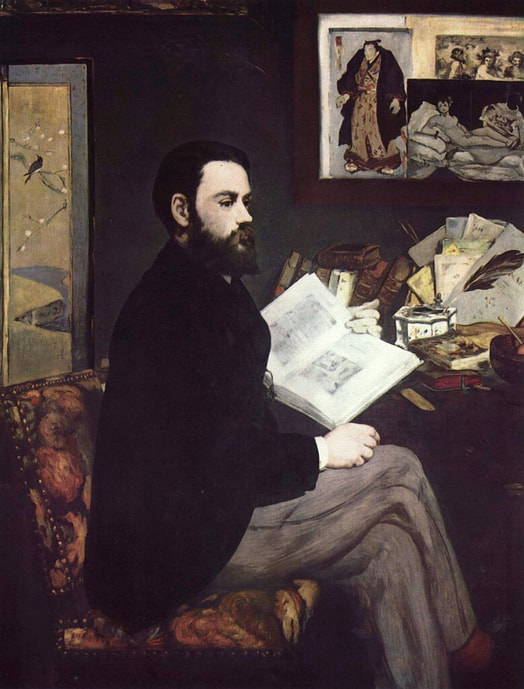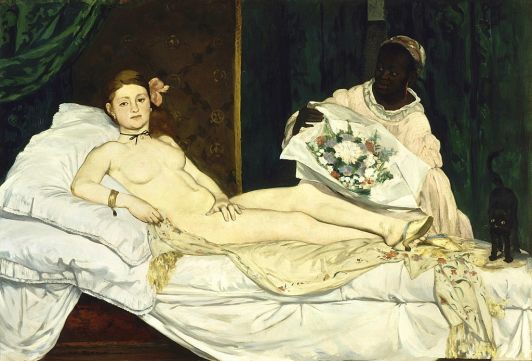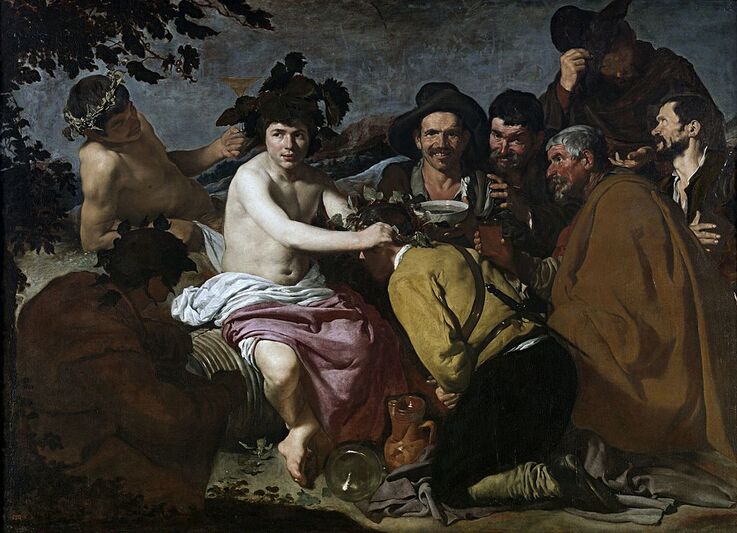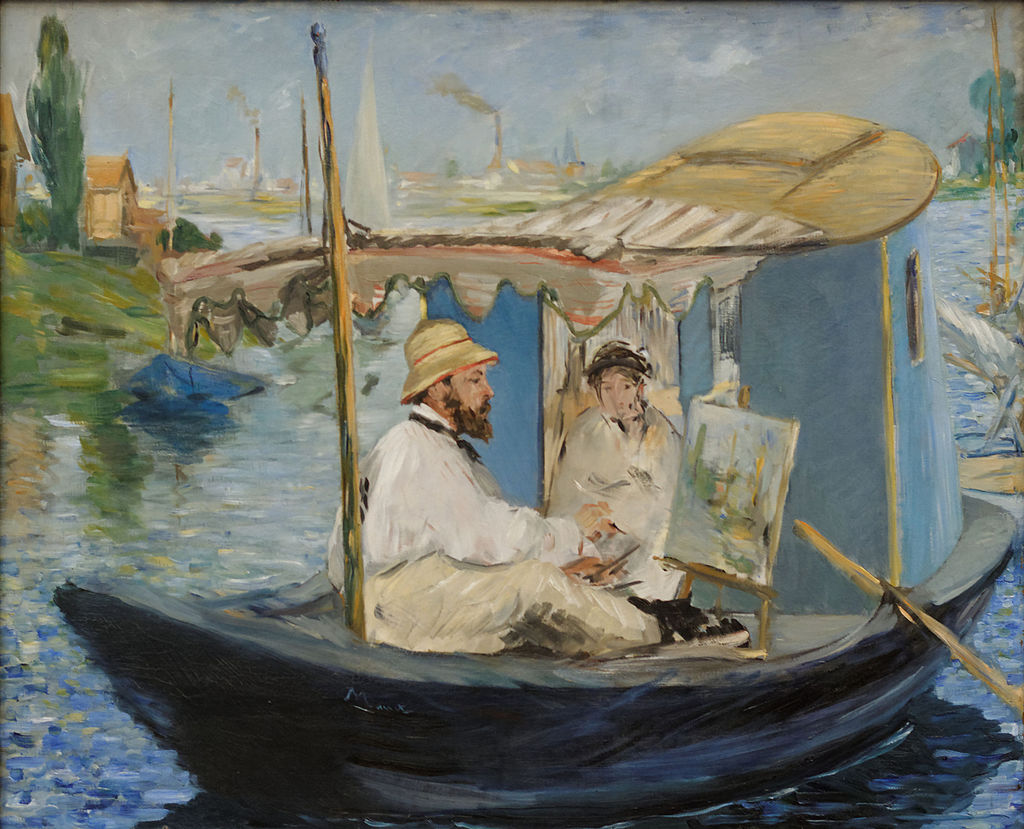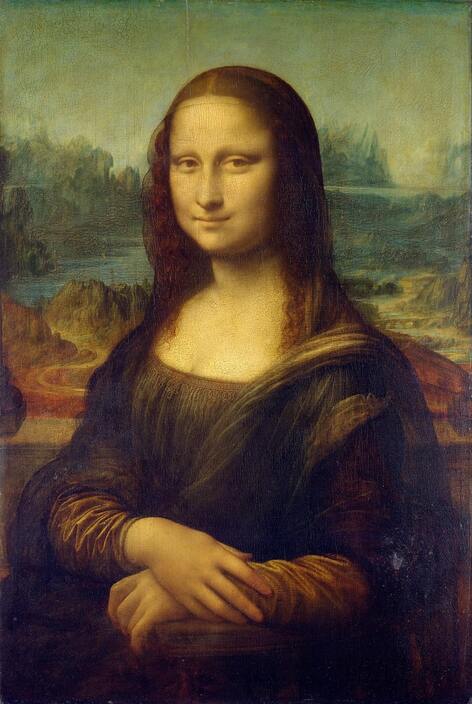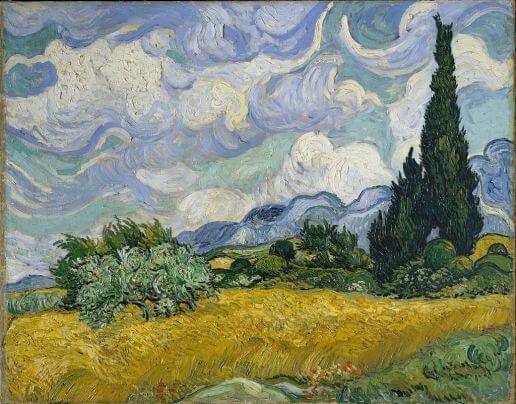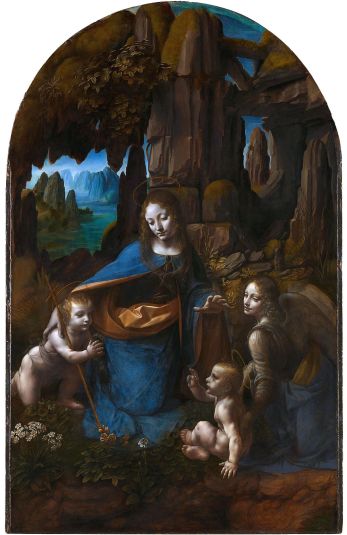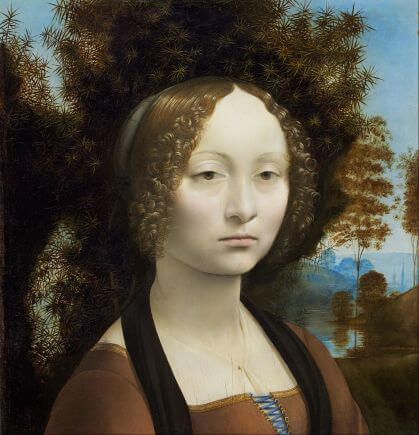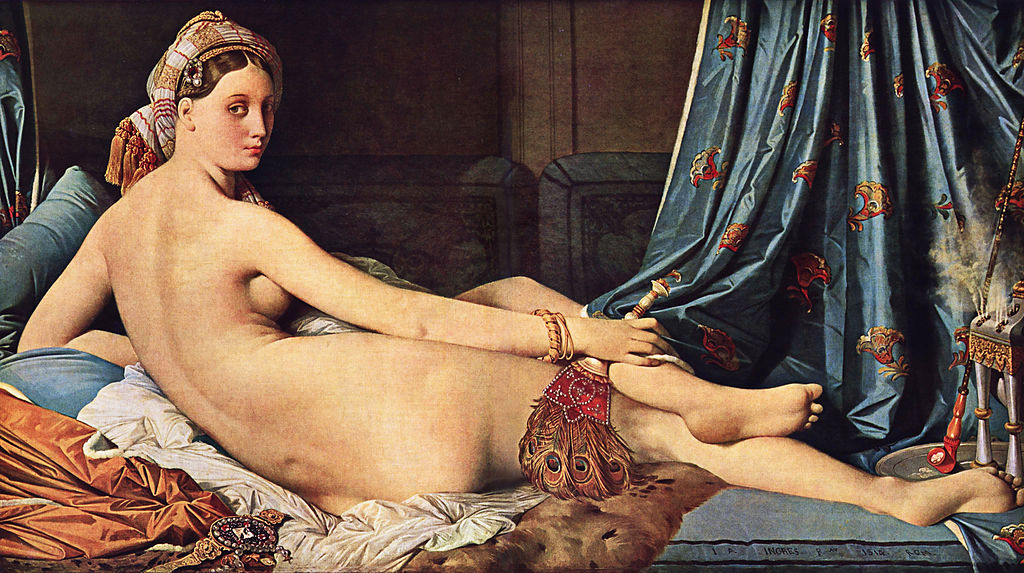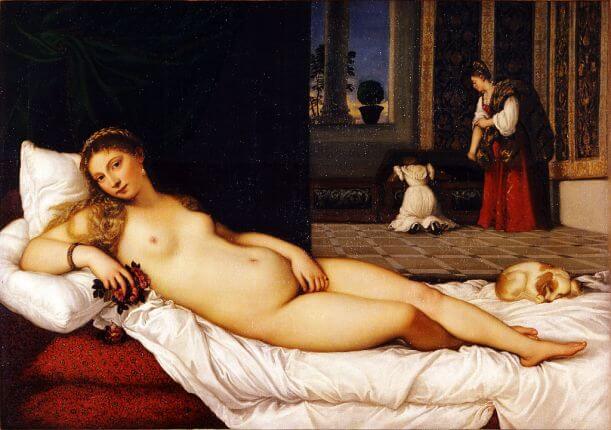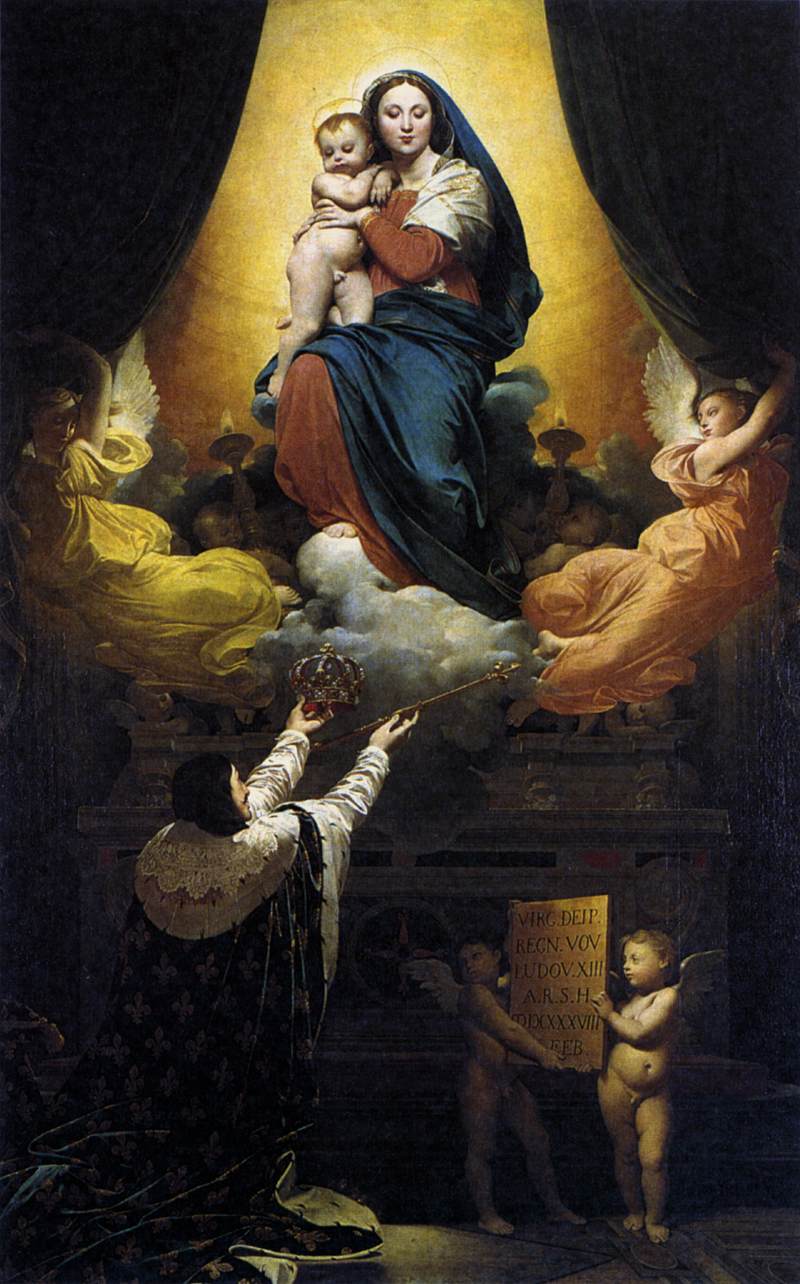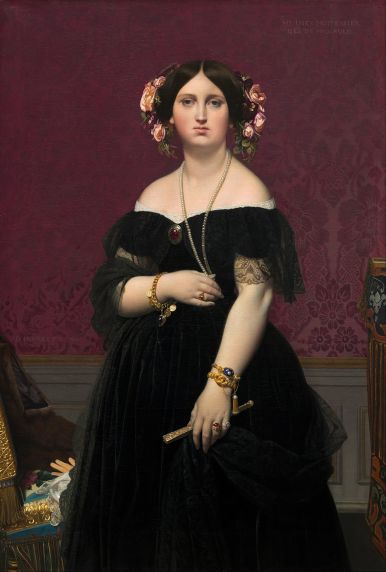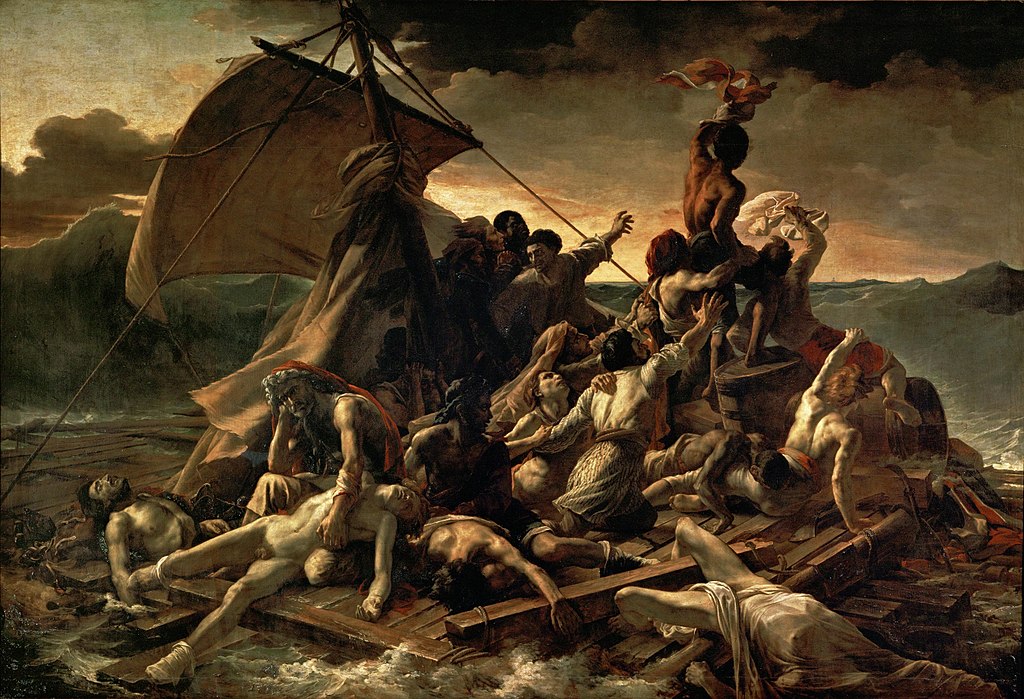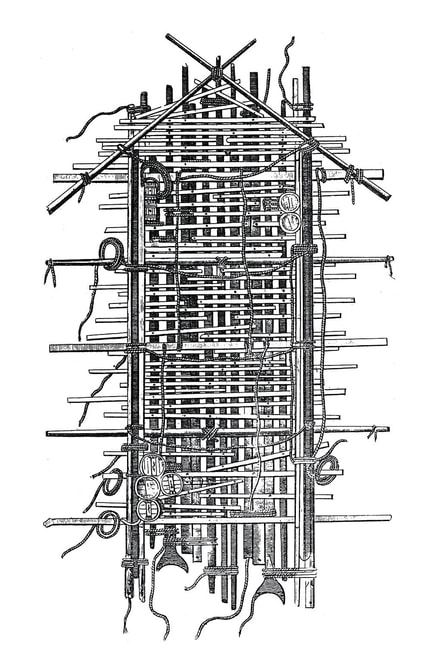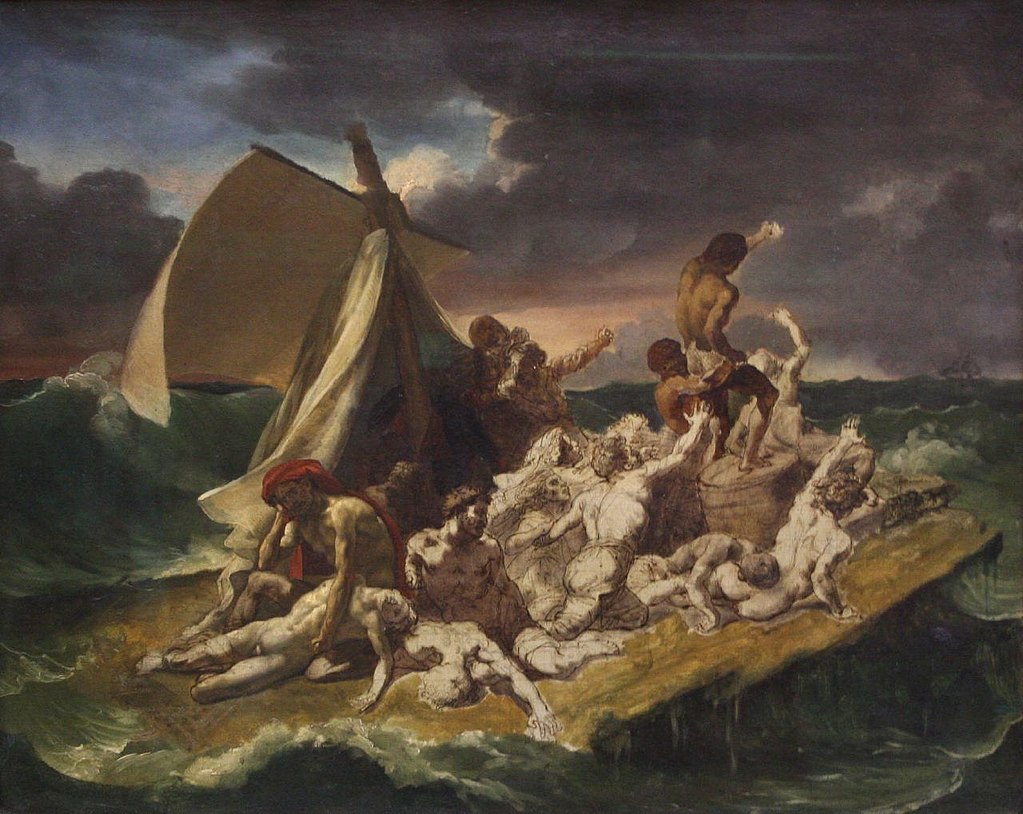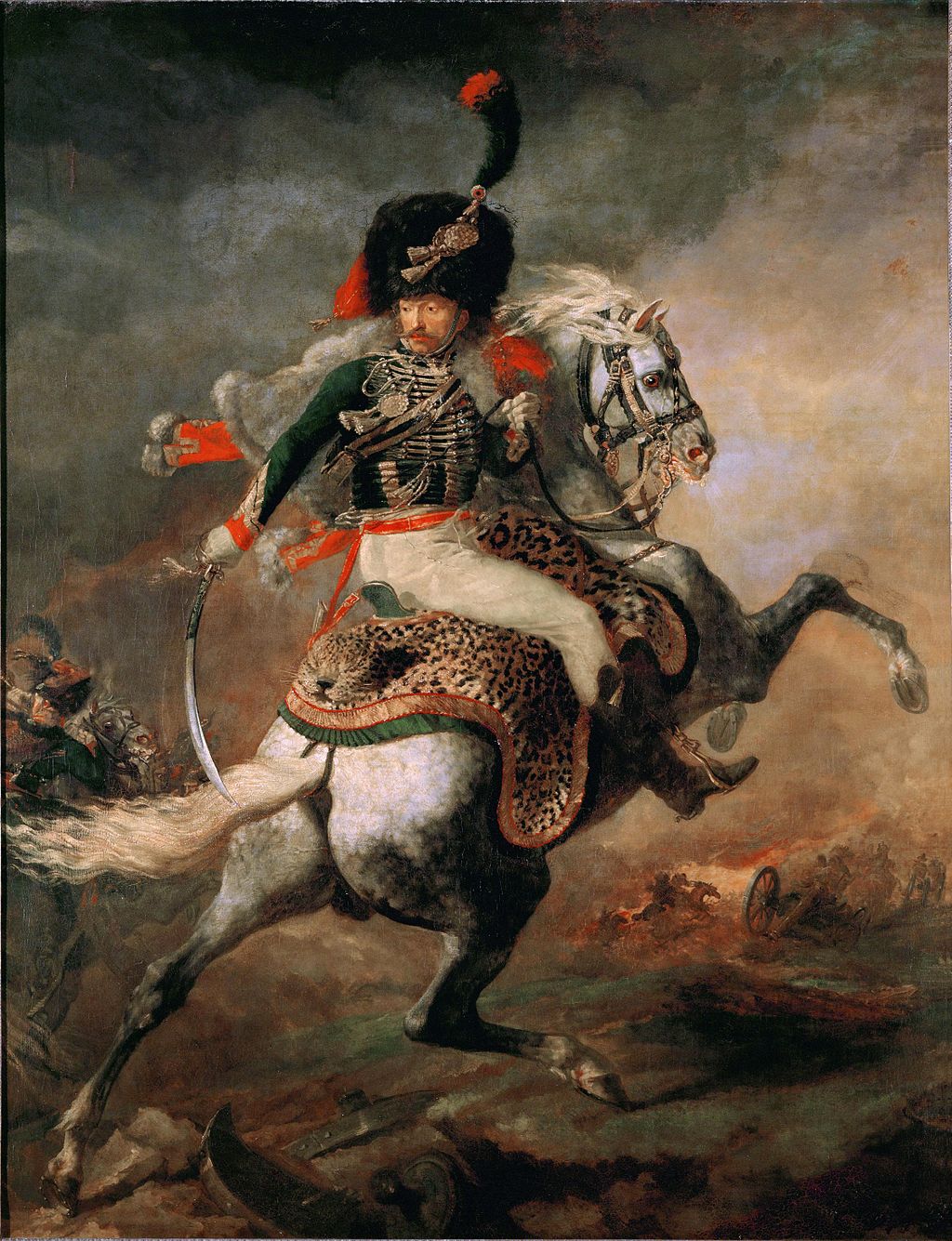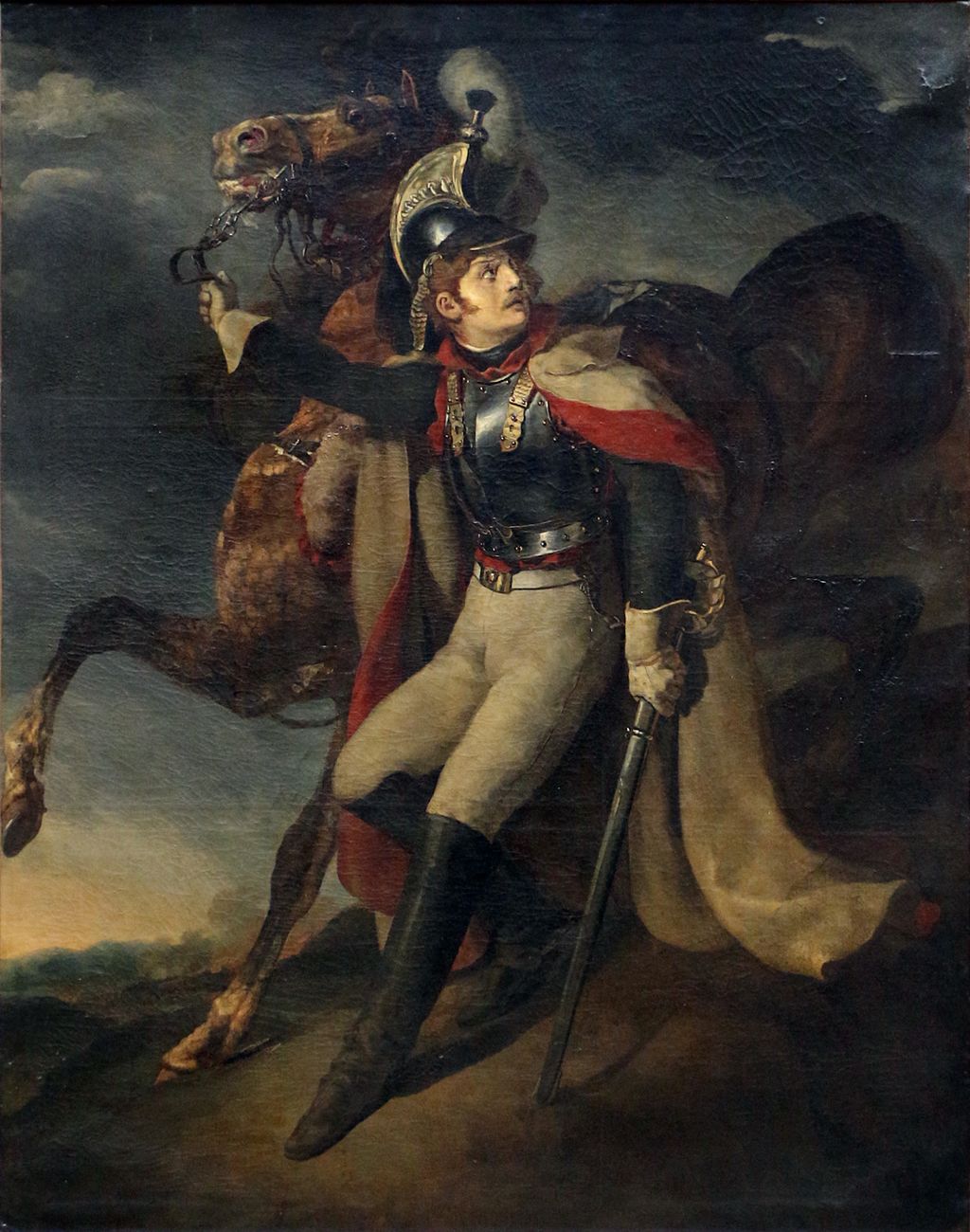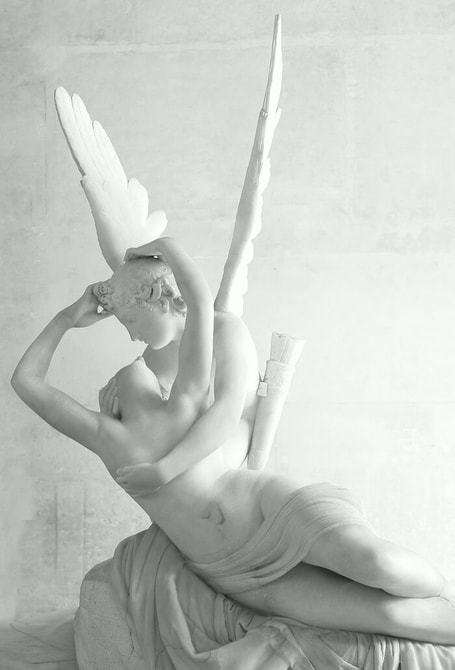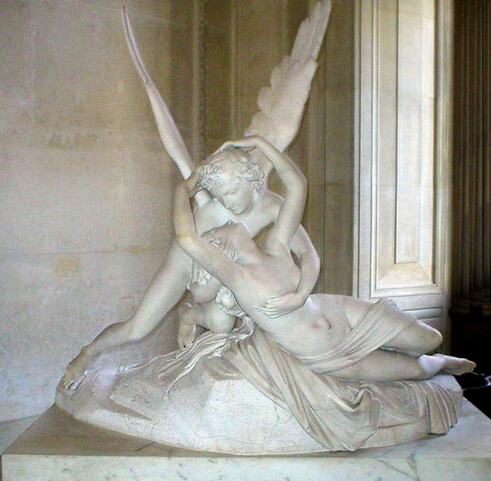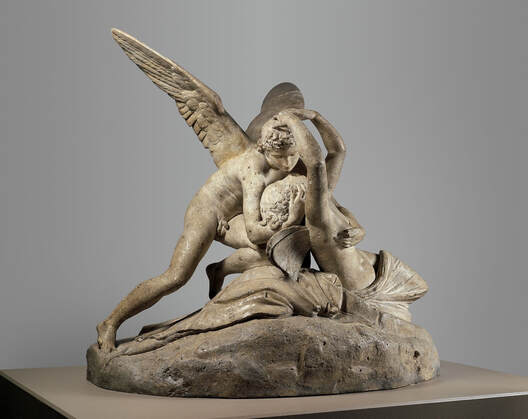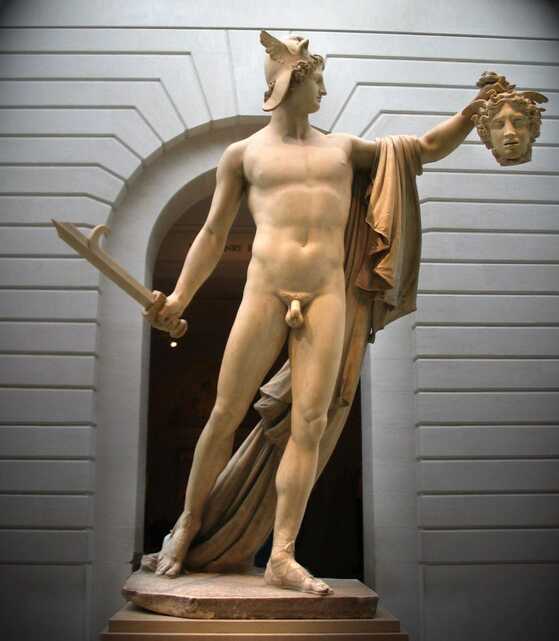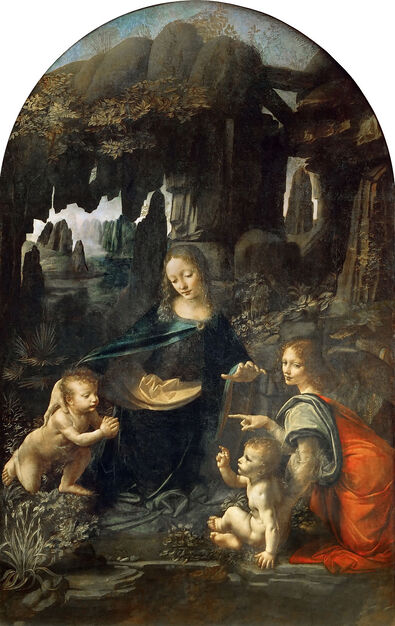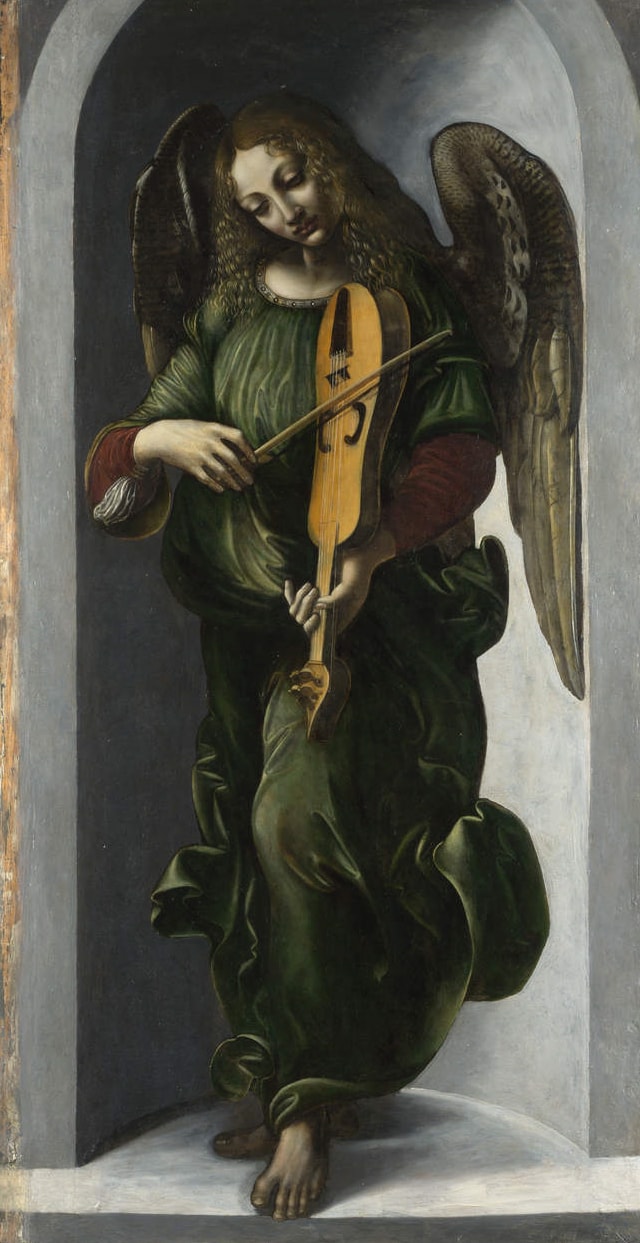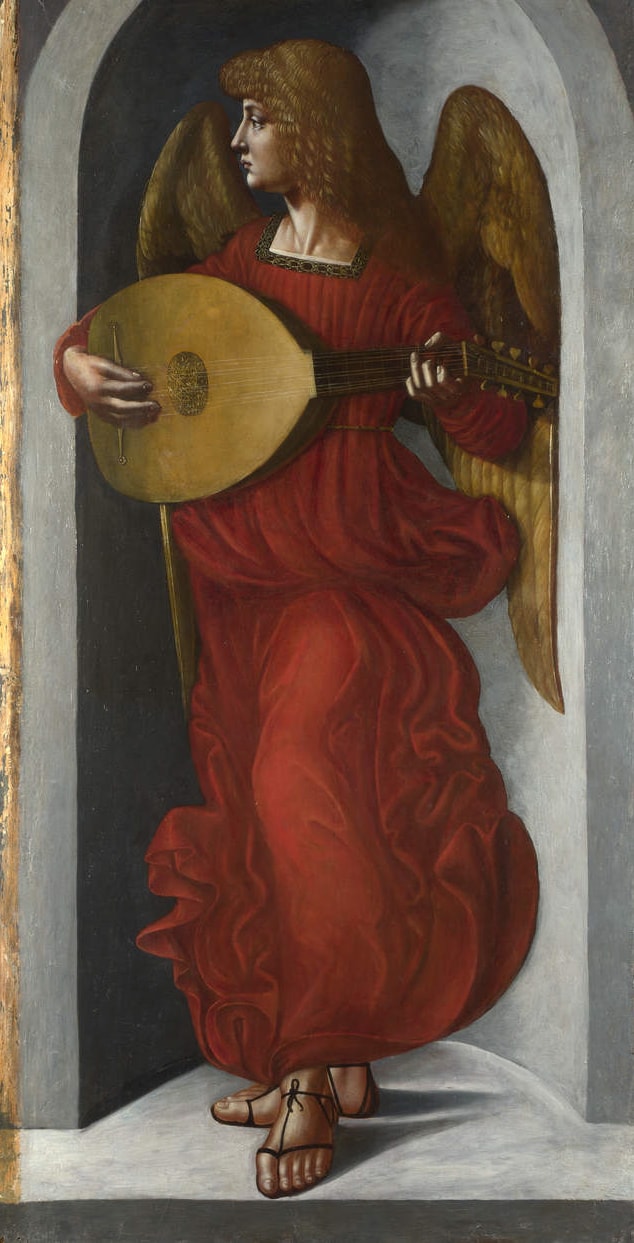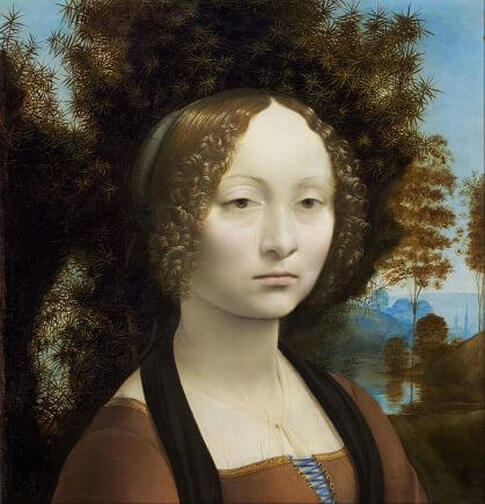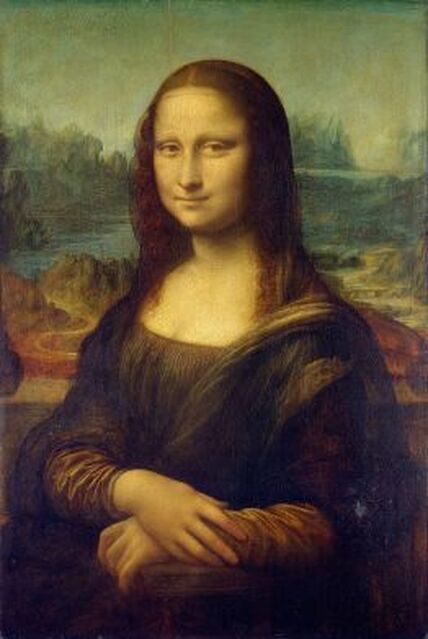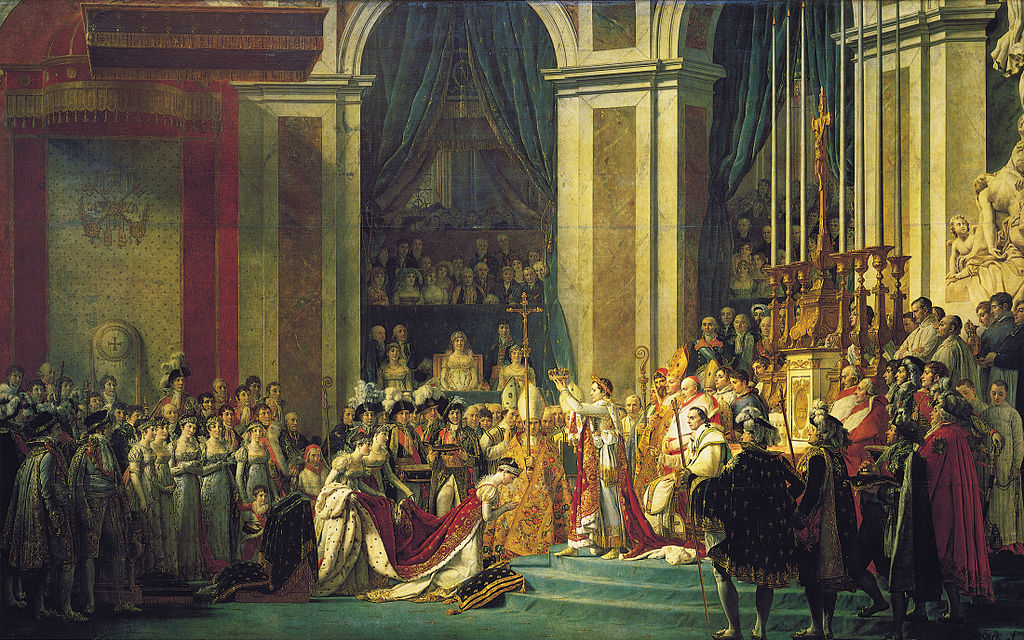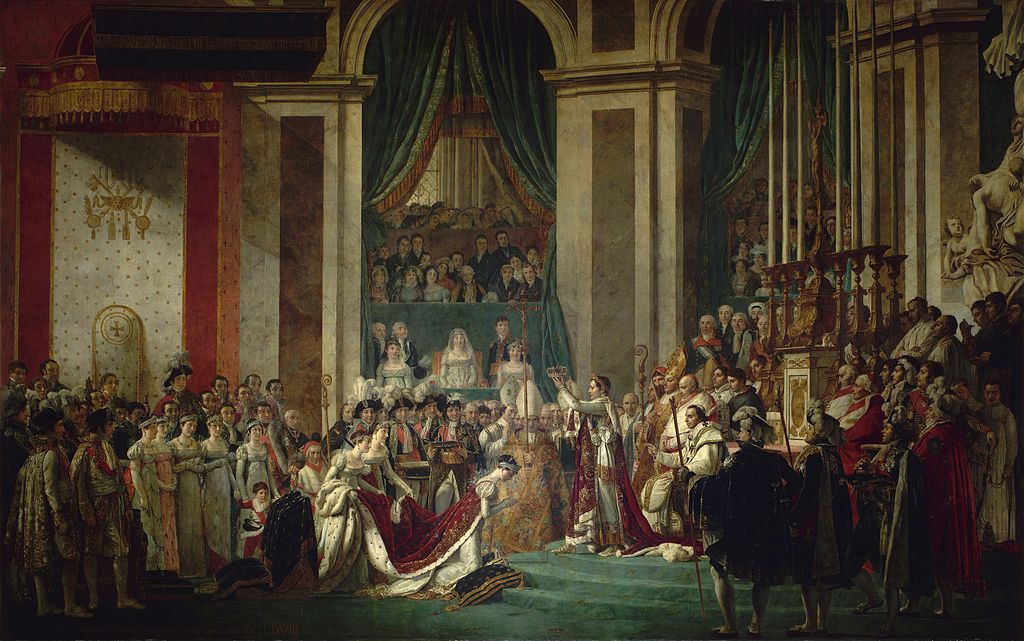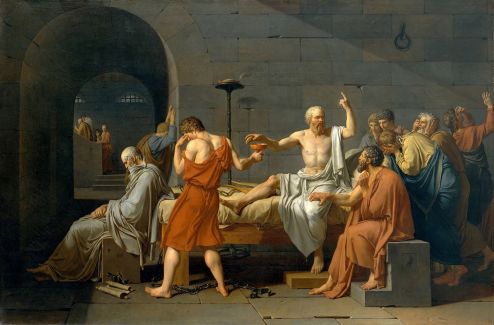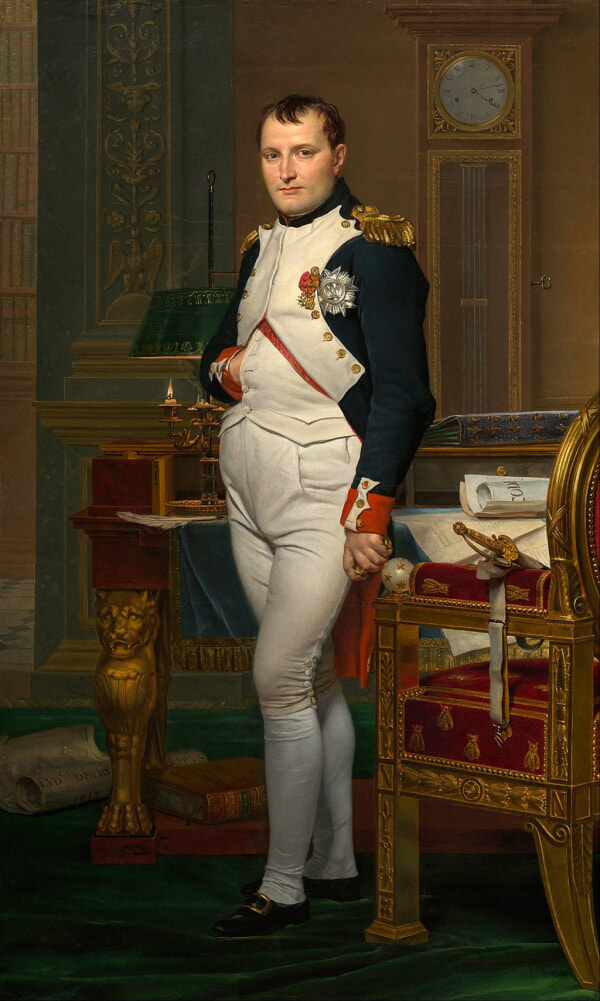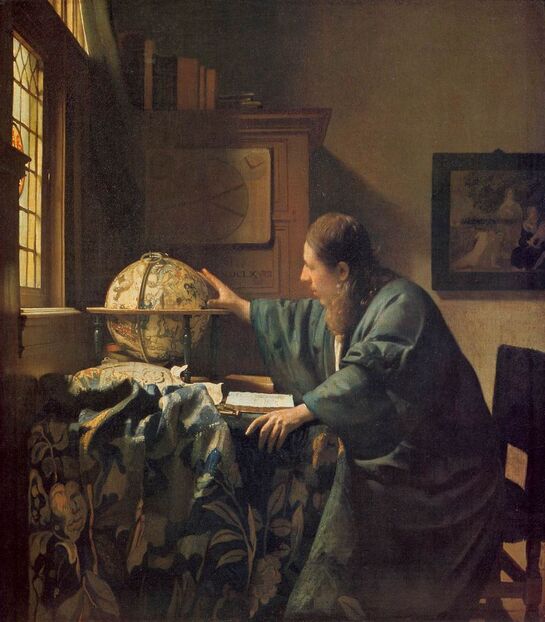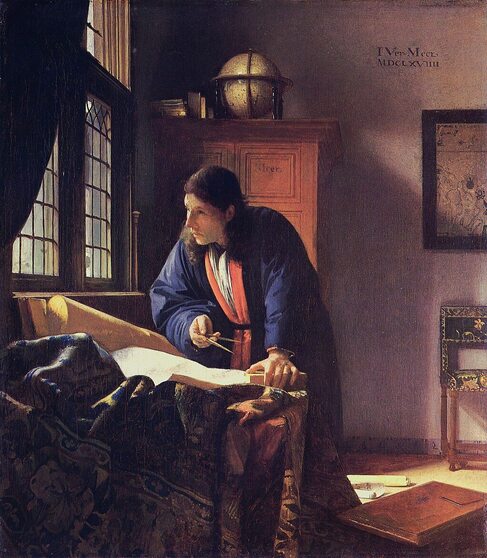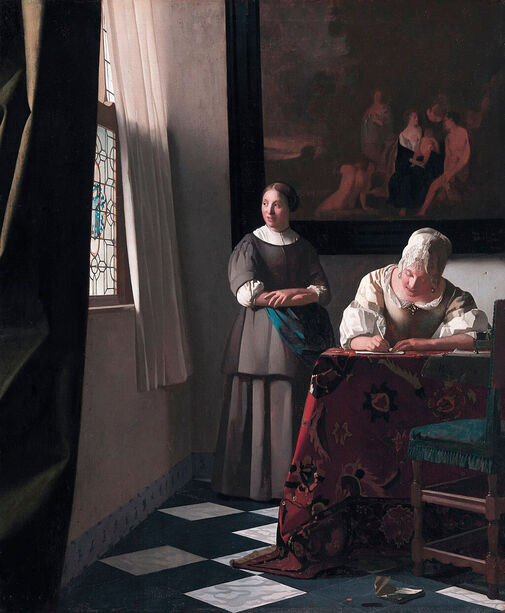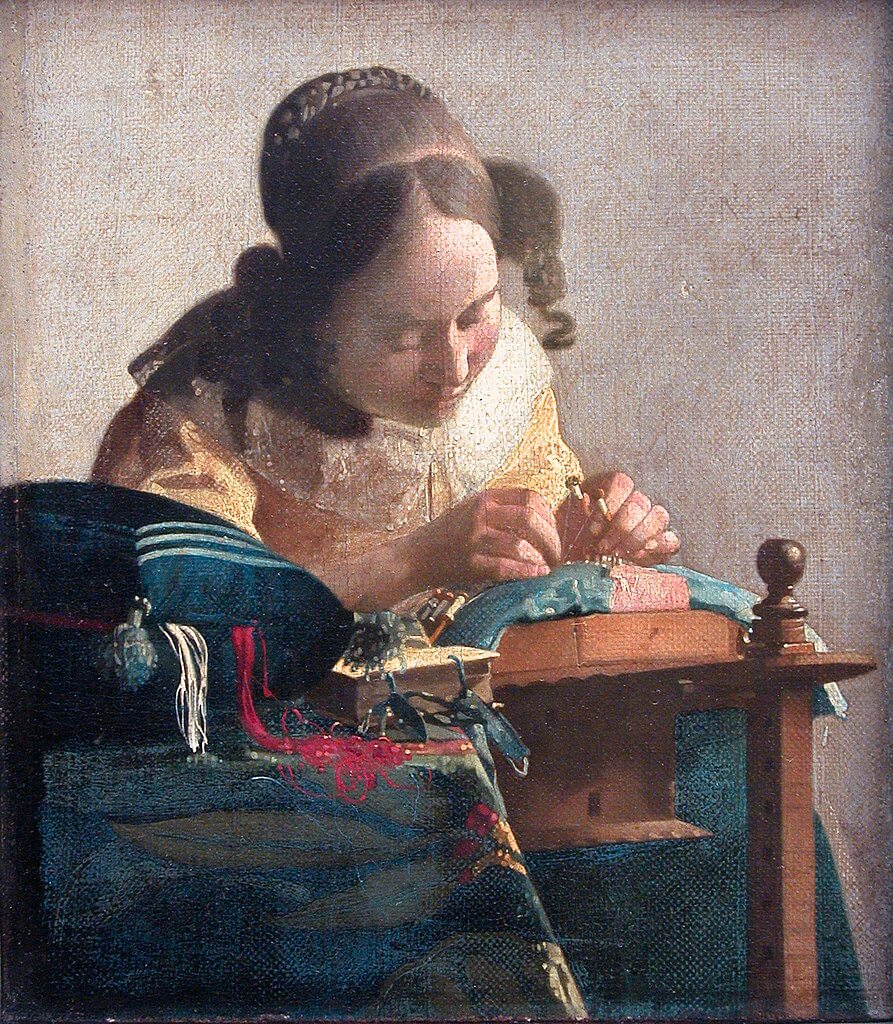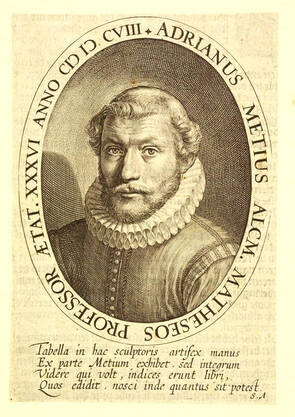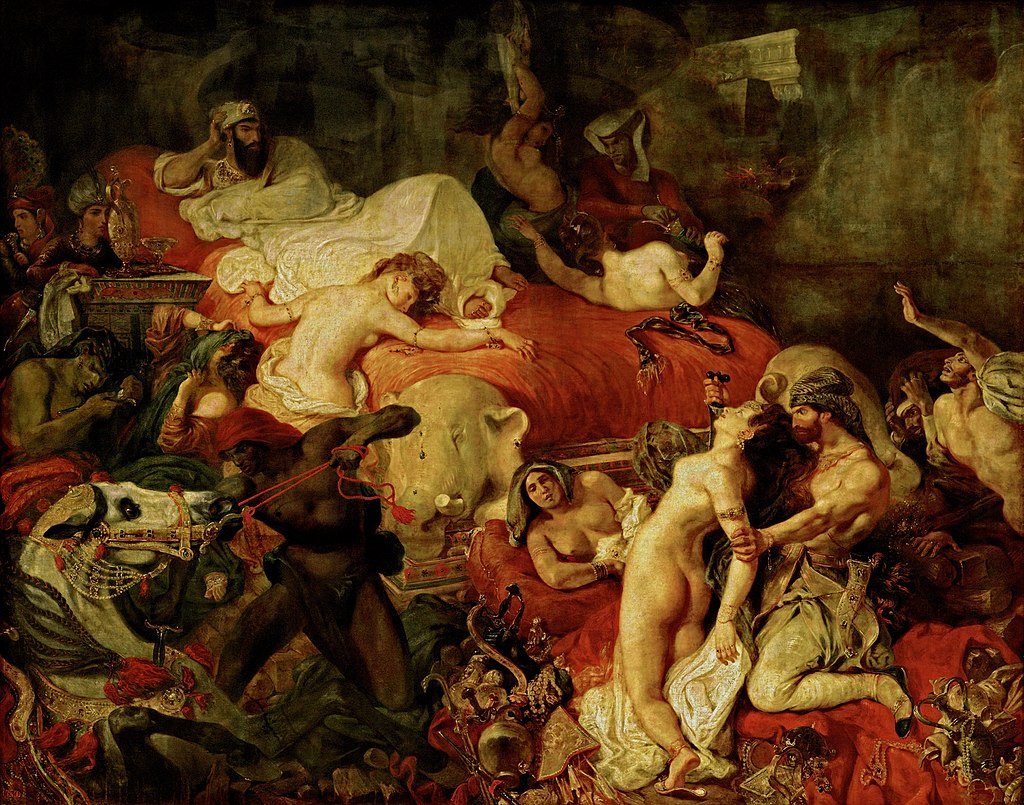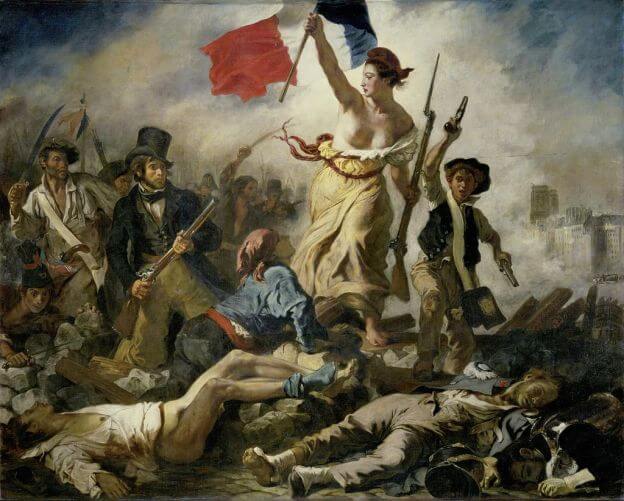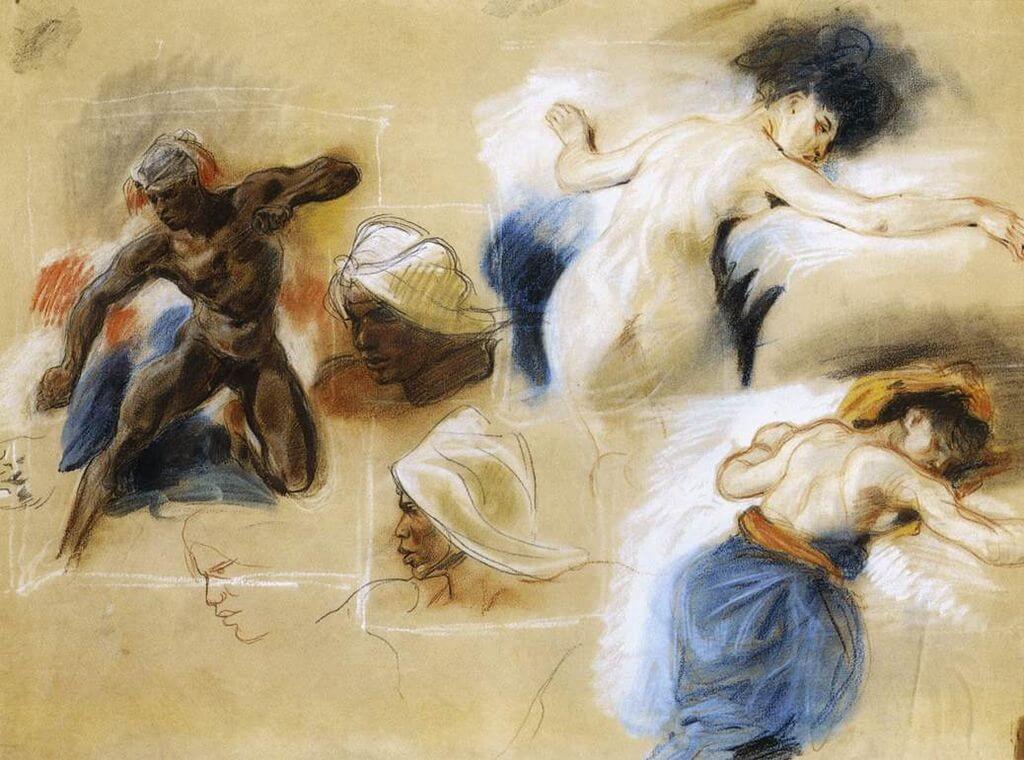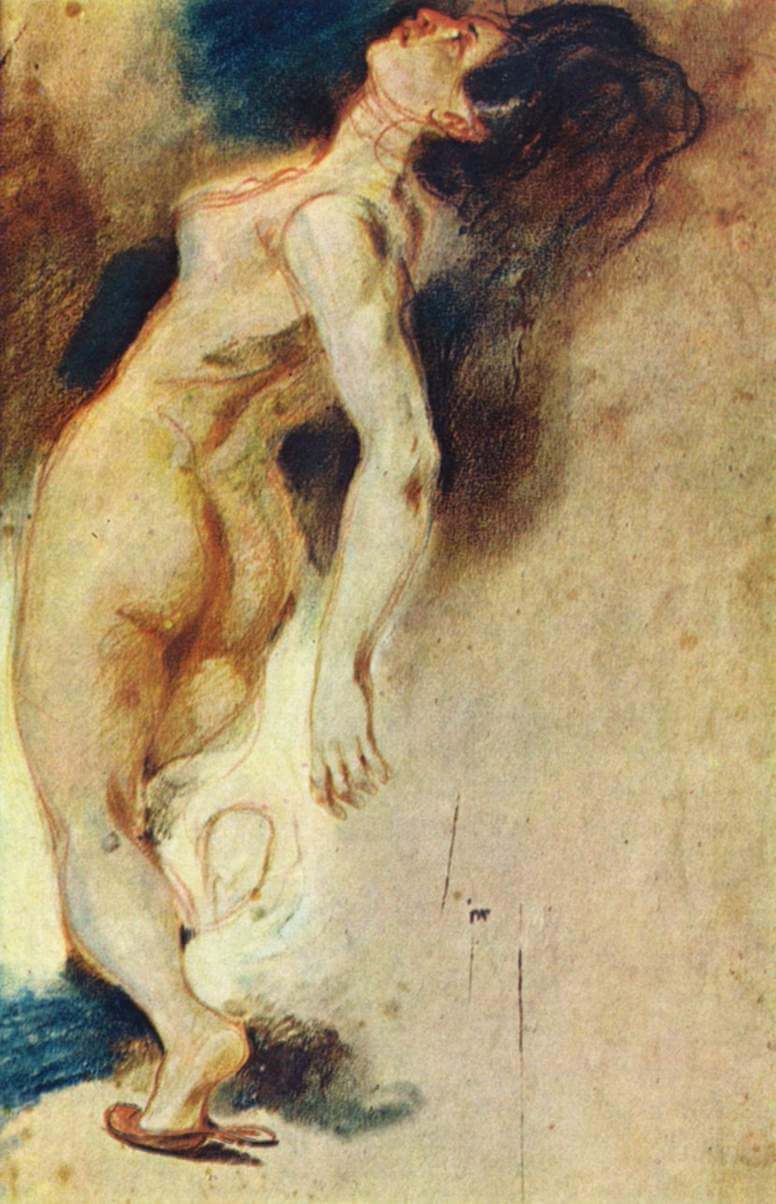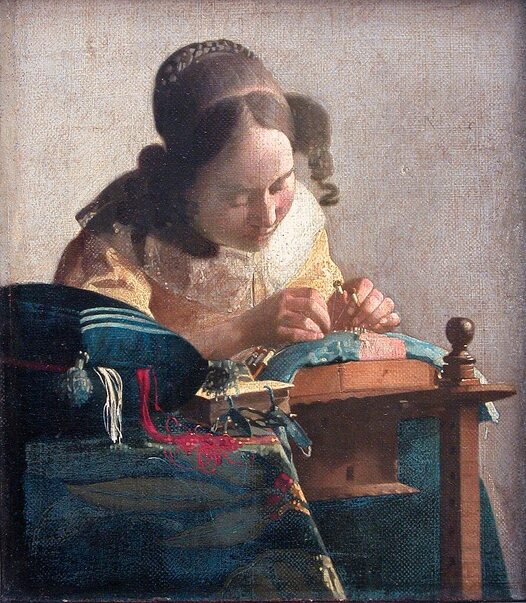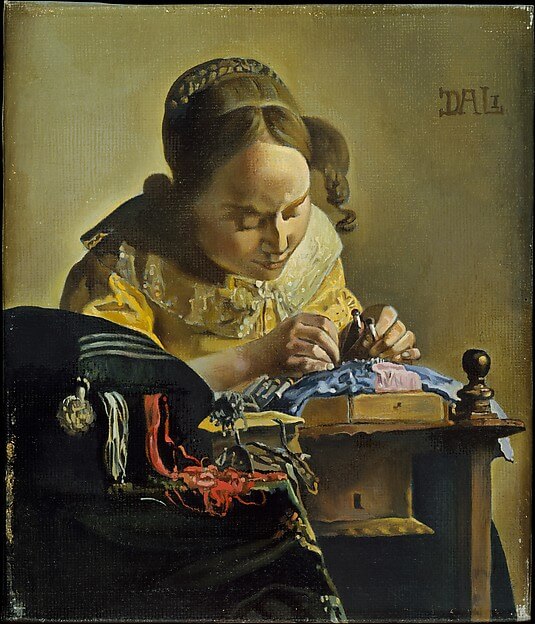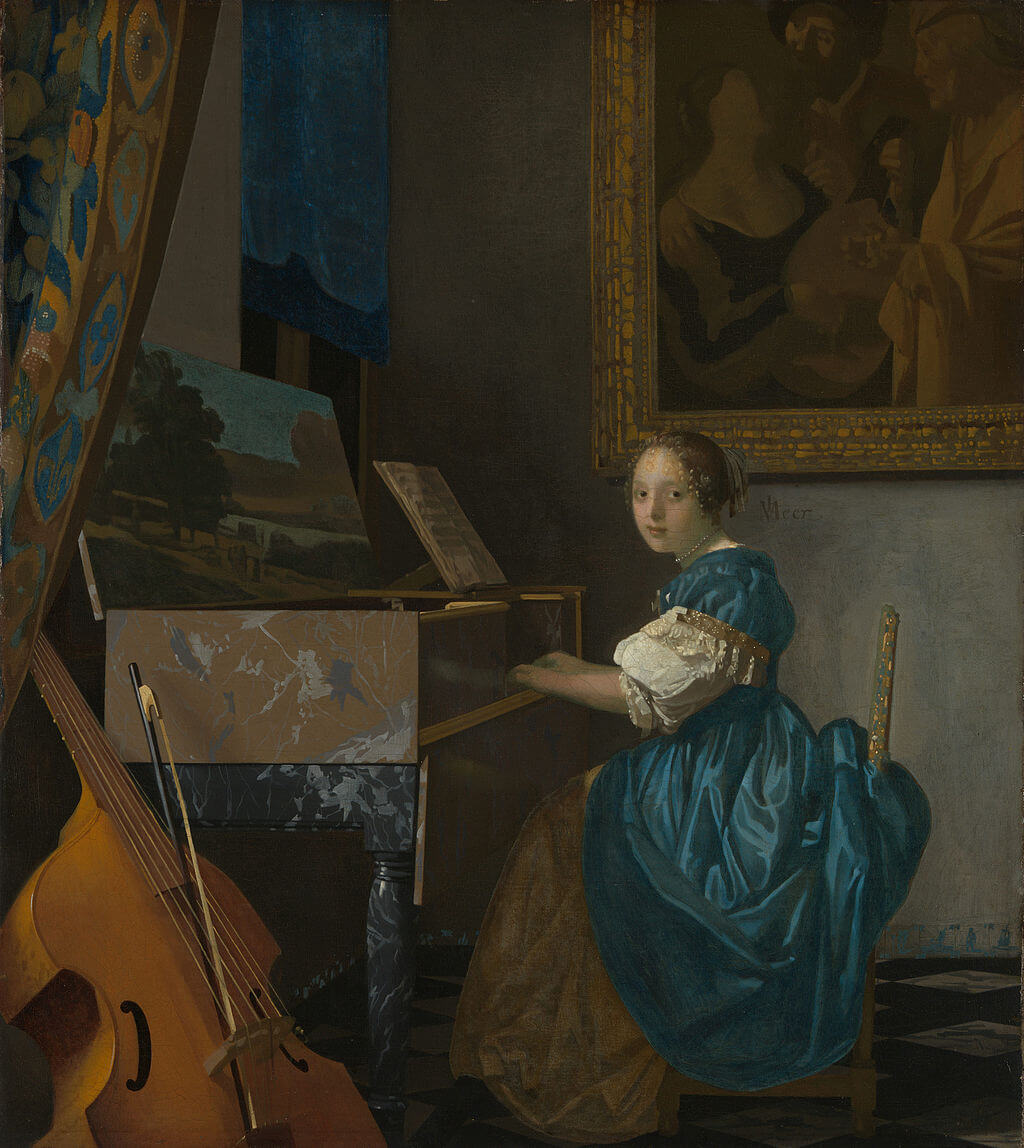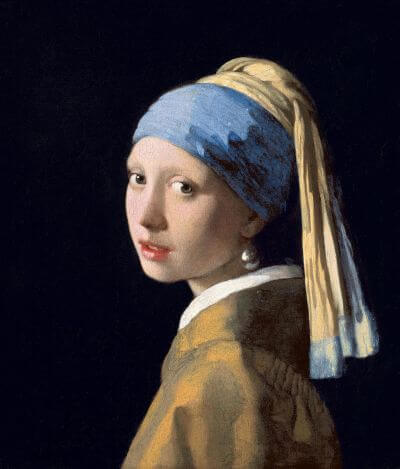|
Where? Room 14 of the Musée d’Orsay
When? 1868 What do you see? The 27-year old writer Émile Zola sits straight in a cushioned chair. He is fashionably dressed as a Parisian dandy, wearing a black jacket with grey pants. One hand rests on his knee, half-clenched. In his other hand, he holds Charles Blanc’s L’Histoire des Peintres, a book about art history. Zola seems to be in thought about something he has just read. The blankness of his expression makes the objects around him the subject of the viewer’s attention. In the background are artifacts from Japan, including an ink well on the desk, a painted screen on the far left, and a print of Utagawa Kuniaki’s Wrestler of Onaruto Nadaemon on the wall. The organized clutter atop his desk accentuates his wit and intellect. Among the books is a light blue pamphlet in which Zola defended Manet controversial painting Olympia. Directly above it is a print of Olympia herself. Behind it is a print of another famous painting, The Triumph of Bacchus by Diego Velázquez.
Backstory: In 1867, Manet had a solo exhibition. His best-known work, Olympia, was put on display for the second time. The work had received much criticism in 1865 for its avant-garde subject matter and “unrefined” style. Upon its second public display, the painting was once again the subject of many harsh comments.
Writer Émile Zola came to Manet’s defense and wrote an article in La Revue du XXe siècle. The article praised Manet’s bold style and technique, asking viewers to overlook the “risque” subject matter. Zola later published the article in its own brochure that sits on his desk in this portrait. As thanks, Manet painted Zola’s portrait. Over the course of several months, Zola posed extensively for the portrait in Manet’s studio. According to Zola, these sessions were long and exhausting as Manet did not engage in much conversation when he was painting. Manet’s main emphases in this portrait were Zola’s intellect and the aesthetics of the Far East. With the influx of Japanese goods into France in the mid-nineteenth century, many artists began imitating the flatness and simplicity of Japanese woodblock prints. This movement, known as Japonisme, was a precursor to Impressionism. Who is Émile Zola? A French writer who was born in 1840 in Paris. He is often credited as a founder of the naturalism movement in literature. He was childhood friends with Paul Cézanne who later introduced him to Manet. Zola was unemployed and lived in poverty for two years of his adult life. It was only when he published his first novel, Claude’s Confession that he was able to land a job as a journalist. Zola went on to write many more novels and published his best-known series, The Rougon Family Fortune. In the 1860s, Zola defended Impressionist artists like Cézanne, Manet, Renoir, and Monet. Who is Manet? Édouard Manet was born in 1832 in Paris where he died 51 years later. He was a Parisian Realist painter who studied in the studio of Thomas Couture for six years. Afterward, however, Manet decided against attending the official art school of the French Academy, the École des Beaux-Arts. Early on in his career, he befriended the poet Charles Baudelaire whose work featured urban outsiders such as prostitutes and street entertainers. Baudelaire’s writing inspired Manet to continue painting unusual characters alongside his other works that featured better-known figures such as musicians and writers. Manet was friends with Monet who he first considered to be a rival. He believed Monet to be copying his work. However, the pair made amends and eventually traveled to Argenteuil together. Many works came out of this trip, including Monet Painting in his Studio Boat.
Fun fact: Manet altered the print of Olympia in his portrait for Zola. Instead of facing the viewer, Olympia is looking at Émile Zola who had publicly defended her after this painting had received so much criticism at the Paris Salon (a very popular yearly art exhibition) of 1865.
Three years later, Manet submitted the painting to the Paris Salon of 1868 where it got accepted. The painting received mixed critical reviews. Some thought that the portrait was one of the best at the Salon of that year, while others thought the painting lacked animation and that it looked more like a still life than a portrait.
0 Comments
Where? First floor, room 711 of the Denon wing in the Louvre
When? Between 1503 and 1517 Commissioned by? Francesco del Giocondo, the husband of Mona Lisa. What do you see? A half-body portrait of Lisa del Giocondo. She is sitting outside in a chair with a straight posture. Her curly hair hangs on her shoulders, and she has a transparent veil on her head (which may be a sign that she is pregnant). She is wearing a dress with a bit of lace and a scarf over the shoulders. The light skin of her contrasts nicely with the darker tones in the rest of the painting. Note that she has no eyebrows, something that was not uncommon in portraits from that time, though research has shown that the Mona Lisa may originally have had some faint eyebrows. Her hands are crossed and laying on an armrest. She looks at us with an ambiguous expression. Her eyes and her small mysterious smile have been intriguing to viewers all across the world. What is she thinking about and what is she looking at? The background shows a rocky landscape, and Leonardo da Vinci was the first to include such a background in a portrait painting. You can see almost snowy mountains, a winding road on the left and a bridge on the right. It seems that the landscape on the left and the right of Mona Lisa do not match up as the left side is lower than the right side. Backstory: Mona Lisa means ‘my lady Lisa. The word ‘mona’ is a short version of Madonna, which means ‘my lady’. This painting is also known in Italian as La Gioconda named after her last name. This painting was a very innovative one in the time that it was painted due to its composition and the painting technique used by Leonardo da Vinci. Da Vinci accepted the commission for this painting during a time in which he had little money. However, soon after he received some big commissions and it took him, therefore, many years to complete this painting. After Leonardo da Vinci started to work in France, this painting was acquired by King Francis I of France. So, Da Vinci never delivered this painting to its commissioner. The painting remained in France ever since and Napoleon Bonaparte put the painting in his bedroom. In 1804, the painting was moved to Louvre and people could now see the painting that Napoleon was sleeping with. The painting is nowadays displayed in a climate-controlled room and behind bullet-proof glass. Sfumato? One of the things that makes this painting so popular is the use of sfumato by Leonardo da Vinci. This is a technique that Da Vinci developed in which he blended colors on the canvas. Sfumato is derived from the Italian word ‘fumo’, which means smoky. When we translate sfumato to English, it means something like soft or blurry. The transitions from light to dark are barely visible on the canvas, and you cannot see the brushstrokes on the painting. The soft transition is in stark contrast to the impressionist paintings, where the brush strokes are very visible. For example, look at Wheat Field with Cypresses by Van Gogh. The use of the sfumato technique leads to more realistic paintings. Other good examples of the sfumato technique are Da Vinci’s paintings of the Virgin of the Rocks of which one version is in the Louvre and another one in the National Gallery of Art. The sfumato technique had a big influence on other artists, including Raphael, who adopted this technique for some of his portraits.
Who is Mona Lisa? Born as Lisa di Antonio Maria Gherardini in the Republic of Florence in 1479, Lisa married with Francesco di Bartolomeo di Zanobi del Giocondo in 1495. She was the third wife of Francesco, who was a merchant and later became a government official in Florence. It seems that their marriage was based on real love, which was not that common during that time, and together they got five children.
Francesco came from a family of art lovers and commissioned a painting of Lisa to celebrate the purchase of a new home. Mona Lisa lived a normal life and apart from this painting not much is known about her. Who is Leonardo da Vinci? Leonardo di ser Piero da Vinci (1452-1519) was born in Vinci in the Republic of Florence. He is considered to be the ultimate Renaissance man as he was not only an artist, but also an astronomer, a geologist, an inventor, a mathematician, a musician, and a writer. Together with Donatello, Michelangelo, and Raphael, he is considered to be one of the four leading artists from the Renaissance. He created a large variety of art, but he often did not finish his works. Among his surviving works are a few portraits including his Ginevra de’ Benci in the National Gallery of Art.
Fun fact: In August of 1911, the Mona Lisa was stolen from the Louvre. This theft was a big shock as the Louvre was heavily guarded and it was a big mystery how the painting got stolen. However, it was not a complete disaster as, in 1911, the Mona Lisa was not yet considered to be the best painting in the world yet. The robbery spurred a lot of attention for the painting in the media.
One of the popular theories from those days was that Picasso stole the painting. The police even questioned Picasso but found no evidence against him. In 1913, the painting was retrieved when an employee of the Louvre wanted to sell the painting for $100,000 to the Uffizi Museum in Florence. After this robbery, the Mona Lisa was suddenly one of the most special paintings in the world, and it has only grown in popularity since. Nowadays, about ten million people visit the Louvre each year, and most of them want to see this painting. Interested in a copy for yourself? Poster of canvas (Amazon links).
Where? Room 702 on the first floor of the Louvre
When? 1814 What do you see? A young courtesan rests atop some brightly colored blue and ochre fabrics from the east. She is surrounded by treasures from the orient—a bejeweled mirror just behind her, a red hookah at her feet, and beautiful patterned drapes that hang from above. She is nude, except for the exquisite oriental headdress atop her head and a few golden bracelets on her wrist. Her elongated right arm holds a beautiful peacock feather fan. She is modestly seductive, her eroticism simultaneously augmented and veiled by the mysticism of the east. Backstory: La Grande Odalisque was commissioned in 1813 by Napoleon’s sister, Caroline Murat, the Queen of Naples. The painting was admitted into the Salon of 1819 but received harsh criticism for a number of reasons. Firstly, this nude by Ingres was different from many reclining nudes of the past as those were painted in a mythological context, making them more appropriate for public display. The most famous work in this genre is the Venus of Urbino by Titian. Ingres, instead, veiled his nude in the mysticism of the east, a theme emphasized by many neoclassical painters like David and Delacroix. Nonetheless, the eroticism caused much discourse. Secondly, Ingres received criticism for his exaggerated and inaccurate rendition of human anatomy. Influenced by the 16th-century Mannerism art movement, Ingres elongated the body of his subject in numerous areas including her spine, right arm, and left leg.
Who is Ingres? Jean-Auguste-Dominique Ingres was a French painter born in born in 1780 in Montauban. His father was an artist and musician, and his mother was a wigmaker. His parents exposed him to the arts from an early age; he enrolled in art school, studying both sculpture and painting.
In 1797, Ingres began studying with Jacques-Louis David, and, in 1799, he was admitted to the Ecole des Beaux-Arts in Paris. Eventually, he won the Grand Prix de Rome, a prestigious art prize that allowed him to work in Rome for five years. While in Rome, he was commissioned by the Murat family in Naples to paint several portraits, though he never received payment for these paintings because of the fall of Napoleon’s empire. Stranded in Rome with no patronage, Ingres resorted to making portraits for English tourists. Soon, Ingres returned to France where he regained popularity with his The Vow of Louis XIII. However, he also continued to paint portraits including his portraits of Madame Moitessier, of which one version is in the National Gallery in London and another version in the National Gallery of Art in Washington, DC.
Fun fact: When looking at the woman, you can clearly see in her lower back that she has a few more vertebrae than normal. Critics of La Grande Odalisque often estimated that Ingres had added three extra vertebrae to his figure. However, a study conducted in 2004 showed that Ingres had actually added approximately five vertebrae to his model. This number was calculated by measuring female models and scaling them to the size of Ingres’s painting. Such an elongation suited the personal taste of Ingres who was influenced by Mannerism. He thought long and curved lines accentuated the sensuality and beauty of a figure.
Where? First floor, room 700 of the Denon wing in the Louvre
When? 1818-1819 What do you see? A moment about two hours before the survivors of a shipwreck are rescued. After spending 13 days on a raft on the open sea – surrounded by big waves – the surviving members of The Medusa notice a ship on the horizon (see the tiny ship on the horizon above the man on the right with a red garment around his upper legs). Some of the survivors frantically try to get the attention of the ship. However, they are unsuccessful at first and only two hours later the ship locates the raft and the survivors are rescued. The improvised raft carries 20 people. It seems that there are four or five dead bodies, mostly in the foreground. The survivor that reaches highest is an African man. Géricault gave this man a very prominent place as a political statement against slavery. The man stands with his right leg on a barrel of wine, which is the only liquid they had to drink on the raft. In the left foreground, a father with a red cloth holds the dead body of his son in front of him. What it the Raft of the Medusa? The Medusa was a French warship. In 1816, it left from Rochefort, France, in the direction of Senegal, where the British would hand over the port of Saint-Louis to the French. The ship carried 400 passengers. Navigational mistakes caused the ship to run aground in shallow water about 30 miles (50 km) from the coast of Mauritania. The ship was damaged, and the passengers needed to be evacuated. However, there were not enough lifeboats to carry everybody. The majority of passengers used the lifeboats to get to the African coast. About 150 people got on an improvised raft of 66 ft (20m) long and 23 ft (7m) wide (see the picture below based on a drawing of one of the survivors). There was very little food on the raft, it was half underwater, and could not be steered. So, these people were lost at sea. Many of them died because of a lack of food, fights, suicide, or cannibalism. When the raft was discovered by a rescue ship 13 days later, only 15 people were alive (of which five died within days after their rescue). Two survivors wrote a book about their experiences and the full text of that book is available for free.
Backstory: Within two months of the rescue, the first accounts of the brutal journey of the raft of the Medusa appeared in French newspapers. These stories caused a big scandal in France and the government tried to cover it up unsuccessfully. Géricault got inspired by these stories and wanted to start a painting about it.
Géricault spoke to two survivors to get an even better idea of what they experienced. He picked a specific moment from their survival story as the subject for this large painting. He also tracked down the carpenter that helped to build the raft from the wooden deck of the Medusa and asked him to create a smaller-scale replica in his studio. Many of the preparatory sketches by Géricault for this painting are still available. A more elaborate sketch that is also owned in the Louvre is shown below. All this preparation resulted in a brilliantly-executed painting. According to many, this is the most famous painting from the Romantic art period.
Moral: The moral is one of despair, hope, and persistence. After 13 days, the people on the raft finally see a ship that could rescue them. However, the ship does not seem to see them. Some people in this painting are still trying to get the attention of the ship, while others have already given up, turned around, and sit down in disappointment.
Who is Géricault? Jean-Louis André Théodore Géricault (1791-1824) was a painter and lithographer from France. He is one of the founders of Romanticism, an art movement that was further developed by Eugene Delacroix. While Géricault received some formal training, he was largely self-educated. He got his inspiration from Michelangelo, Gros, and especially Rubens. Géricault was a specialist in painting horses. His first masterpiece, The Charging Chasseur, which is also in the Louvre, was accepted for the Paris Salon of 1812. Two years later another painting of him got accepted by the Salon, entitled The Wounded Cuirassier, which is on display both in the Louvre and in the Brooklyn Museum of Art in New York.
Fun fact: The Raft of the Medusa painting was a controversial one and Géricault was aware of that. The painting was a political statement against the government who had failed in appointing a proper captain to the Medusa and, subsequently, tried to cover up their mistakes in handling the aftermath.
Géricault used a canvas of 23.6 ft (716 cm) wide and 16.1 ft (491) cm high, making the figures in this painting larger than life-size. He knew that he would not sell this painting as it was too big for a private home and the government would not buy it. The painting got accepted for the 1819 Paris Salon and immediately went viral, becoming the talk of the town. As expected he did not sell it, but he earned some money when the painting toured various exhibitions in Europe, where the painting was received positively. Interested in a copy for yourself? Poster.
Where? Ground floor, room 403 of the Denon wing in the Louvre
When? 1787-1793 Commissioned by? Colonel John Campbell What do you see? The moment at which the lifeless body of Psyche is just brought back to life by Cupid. The figures of Cupid and Psyche (except the wings) are positioned in a pyramid shape, which creates a stable form for the sculpture. Cupid sits on one knee on top of a rock and holds Psyche by her head and breast. He has large wings pointing straight up into the air and wears his arrows in a quiver on his back. Psyche reaches up to Cupid and has her hands on his head. She lets her head hang back and they are about to kiss. Her long hair reaches all the way to the ground. She has a cloth wrapped around her lower body. Behind them lays the flask with the ointment that Psyche had collected from the underworld. Directly to the right of the flask is Cupid's arrow, which he used to wake up Psyche. This story symbolizes the big efforts and challenges a human must undergo to achieve happiness and immortality. Look also at the precision with which Canova created the smooth bodies of Cupid and Psyche. This smoothness contrasts nicely with the wrinkly texture of the sheet wrapped around Psyche and the rougher texture of the rock on which they sit. Near the right foot of Psyche is a handle, which was originally included to turn the sculpture around as it was worth seeing this sculpture from all possible angles.
Backstory: This sculpture is based on a story the Roman writer Apuleius wrote in his book Metamorphoses, chapters four, five, and six (you can download the book here for free). In short, Psyche was considered the most beautiful woman alive, and Cupid fell in love with her. The painting Cupid and Psyche in the Cleveland Museum of Art by Jacques-Louis David shows the couple after they made love.
The goddess Venus was jealous of Psyche's beauty and sent her on a very dangerous journey to the underworld to collect a flask with Proserpina’s beauty ointment. Psyche succeeds with the help of Cupid. Venus instructed Psyche not to open the flask, but after she completes the journey, she could not resist and opened it to take some of the content. But instead of becoming more beautiful, the ointment makes her fall in a very deep sleep as Proserpina had filled the flask with sleep of the innermost darkness. Cupid forgives Psyche and revives her. He asks for the help of Zeus who makes Psyche immortal. Cupid and Psyche marry and stay together forever. Multiple Versions: Antonio Canova created another version of this statue for the Russian art collector Prince Yusupov. This version was made in 1796 and is now in the Hermitage Museum in Saint Petersburg. It differs somewhat from the current version as Yusupov asked for some changes. For example, he wanted the cloth on Psyche to cover her legs completely. The favorite student of Canova, Adamo Tadolino, inherited the plaster model for this sculpture, which is now at the Metropolitan Museum of Art. He used this model to create at least five known marble replicas of this sculpture with small modifications. He added, for example, small butterfly wings to the back of Psyche and created smaller wings for Cupid.
Who is Psyche? One of the three daughters of an unknown king and queen. She was very beautiful, and people treated her like a goddess. Venus was jealous of her beauty and the way she was treated. She asked her son Cupid to use his arrows to make her marry the ugliest of all human beings. However, when Cupid saw Psyche, he fell in love with her.
Psyche's father went to an oracle to ask why her daughter had not married yet. The oracle said that Psyche should be left behind there immediately as otherwise terrible disasters would happen. Next, the god Zephyr blew her away and put her in a palace by herself. There, every night she made love to a person that she was not allowed to see. This person was Cupid. When she discovered this, Cupid fled. To get him back, Psyche followed the instructions of Venus to gather a beauty ointment from the underworld as described above. Who is Canova? Antonio Canova (1757-1822) was born in Possagno, a small town in the Northeast of Italy. He studied arts in Venice and then moved to Rome at age 23 to start his own workshop. He completed various commissions for the Pope while in Rome. In 1802, he moved to Paris where he created several sculptures for Napoleon. He was inspired by the ancient Greek and Roman sculptures. He revived this classical style and Canova is considered to be the prime Neoclassical sculptor. His sculptures are praised because of their perfect form and finish. The careful finish of the human bodies makes his statues look like real flesh and makes them come alive. An example of another great sculpture of Canova is Perseus with the Head of Medusa in the Vatican Museums. A replica of this statue can be found in the Metropolitan Museum of Art.
Fun fact: Canova conducted extensive research to create this sculpture. The position of Cupid is copied exactly from a painting he saw in Herculaneum near Naples. After many sketches, he then created numerous clay figures of the sculpture. Unlike many other sculptors who created small-sized clay models for a sculpture, Canova created the clay models at their real size. This helped him to accurately sculpt his work in marble.
Note that the flask and the wings of Cupid are sculpted separately and are inserted into the rest of the sculpture. For example, you can still see some marks on where the wings are attached to Cupid’s back. Finally, Canova had special curved chisel tools designed for him, which he used to carve out the sculpture’s most inaccessible places. This attention to detail makes him one of the most admired sculptors in history.
Where? First floor, room 710 of the Denon wing in the Louvre
When? 1483-1486 Commissioned by? Prior Bartolomeo Scorlione and the Confraternity for the Chapel of the Confraternity of the Immaculate Conception in the church of San Francesco Maggiore in Milan. What do you see? The Virgin Mary, the children Jesus and John the Baptist, and an angel are pictured in a triangular composition in a rocky environment. The Virgin Mary sits on the ground, which is referred to as the Madonna of Humility. She is the center of attention in this painting. The right hand of Mary is on the shoulder of John the Baptist (who is the child on the left). The left hand of Mary is right above the head of Jesus, which can be interpreted as a protective gesture. John the Baptist is folding his hands and is praying towards Jesus. At the same time, Jesus, who is directly to the left of the angel, is raising his right hand to bless John the Baptist. The angel most likely represents the Archangel Gabriel, even though the angel looks quite feminine (the painting of androgynous figures was a trademark of Leonardo da Vinci). The angel is pointing towards John the Baptist. In the background you can see the rocky grotto and a river, most likely inspired by the Dolomite Mountains, which are to the northeast of Milan. In the foreground and in the grotto various flowers and plants are depicted (including irises, lilies, and ivy). The painting has been finished using the sfumato technique, the smoky/hazy effects, which creates a somewhat magical atmosphere. Backstory: The commissioner of this painting wanted Leonardo da Vinci to paint the Immaculate Conception (a Catholic dogma that Mary was born without sin) to serve as the center of an altarpiece for the Chapel of the Immaculate Conception. This chapel is part of the Saint Francesco Grande church in Milan, and the chapel was founded before 1335 by Beatrice d’Este, who was the wife of Galleazzo I, the Duke of Milan. On the left and right of this painting would be two paintings of angels playing a musical instrument to complete the altarpiece. On the left is An Angel in Green with a Vielle painted by an associate of Leonardo, possibly Francesco Napoletano. On the right is An Angel in Red with a Lute by Giovanni Ambrogio de Predis. The Virgin of the Rocks in the Louvre is thought to be painted entirely by Leonardo da Vinci, which is not always the case for paintings of Leonardo.
Symbolism: This work contains several symbolic references:
This painting is also one of the first known paintings in which the halos are left out. The halos were used in the Middle Ages to indicate that somebody was holy or sacred but were in contrast to the realistic painting style of the Renaissance. What is sfumato? Sfumato comes from the Italian sfumare, which means ‘to evaporate like smoke’ and Leonardo da Vinci famously used the sfumato technique to create the atmosphere in his paintings. Leonardo applied the sfumato technique when the painting was almost finished by applying a coat of a mix of varnish and black pigment to create a hazy/smoky effect. Who is Leonardo da Vinci? Leonardo da Vinci (1452-1519) was born in the Italian village of Anchiano, which was very close to Vinci, which is where he got his name from. He was an architect, astronomer, engineer, inventor, mathematician, musician, painter, writer, and more. Leonardo da Vinci is known to be one of the biggest multi-talented people that the world has ever seen. Leonardo was notorious for being substantially late in delivering his paintings and was not afraid to abandon projects halfway. Leonardo has created a few famous portraits, including Ginevra de' Benci in the National Gallery of Art and the Mona Lisa in the Louvre.
Fun fact: Interestingly, there are two versions of this famous painting. The other version of The Virgin of the Rocks is in the National Gallery in London. The version in the Louvre was the first to be completed and is much less conventional.
For example, the version in the National Gallery contains halos on top of the heads of John the Baptist, Jesus, and Mary, and John the Baptist is carrying a cross with him (these elements are not present in the version in the Louvre). You can also see a clear difference in the face of Jesus. Also, in the National Gallery version of the painting, the angel is not pointing at John the Baptist and seems to gaze into the distance (as if the angel is dreaming/imagining this scene, instead of participating in it). The reason that there are two versions of this painting is that the Confraternity rejected the first version of Leonardo. It was not traditional enough (for example, no halos and a lack of symbolism) and thus did not suit the purpose of representing the dogma of the Immaculate Conception (which was the sole purpose of the Confraternity). Leonardo da Vinci considered the Louvre version of the painting a real masterpiece in which he could perfectly express his artistic ideas. After the Louvre-version of the painting was rejected, Leonardo created another version of this painting (the version in the National Gallery in London), which included all elements that the Confraternity asked for. Interested in a Copy for Yourself? Poster or canvas. 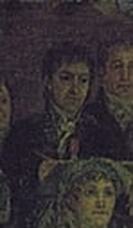 Jacques-Louis David in the background Jacques-Louis David in the background
Where? The original is on the first floor, Room 702 of the Denon wing in the Louvre. A copy by David is in The Coronation Room of the Palace of Versailles.
When? 1805-1807 Commissioned by? Napoleon Bonaparte Also known as? This painting is officially entitled The Coronation of the Emperor Napoleon I and the Crowning of the Empress Joséphine in Notre-Dame Cathedral on December 2, 1804. What do you see? A large number of almost life-size figures are present in the Notre-Dame Cathedral for the coronation of Napoleon Bonaparte. This painting (979cm x 621cm) is one of the largest works in the Louvre. Napoleon is the person in the middle holding the crown, and the painting shows the moment that Napoleon is about to place the crown on the head of his wife Joséphine who is kneeling on a pillow. Napoleon wears his coronation robe, which is similar to the robes worn by Roman emperors. The person sitting to the right of Napoleon is Pope Pius VII. He blesses the coronation but is participating involuntarily under the pressure of Napoleon. The woman in the white dress sitting on a chair in the center of the painting is the mother of Napoleon. In the left foreground, you can see the two identically dressed (wearing black hats) brothers of Napoleon, Joseph (on the left) and Louis (on the right). To the right of Napoleon’s brothers are his three sisters (also identically dressed). From left to right, they are Caroline, Pauline, and Elisa. To the right of Napoleon's sisters, and again similarly dressed, are Hortense (the daughter of Joséphine) and Julie Clary (the wife of Joseph Bonaparte). In the background, Jacques-Louis David also painted himself as he was present at this event. Finally, look at the expressions of all the 204 faces in the painting. They all look quite serious, signifying the importance of this event. Backstory: This painting captures an important event in history, and Jacques-Louis David was in the audience that day. On December 2, 1804, the 35-year-old Napoleon Bonaparte crowned himself during a five-hour ceremony as the first Emperor of France. And he crowned his 41-year-old wife Joséphine as the first Empress. Before the French Revolution of 1789, France was a monarchy, but the revolution turned France into a republic. This painting shows the moment that Napoleon turned France back into a monarchy. He brought in Pope Pius VII from Rome to bless him at the event. The painting is a fairly accurate representation of history, but not everything in the painting is true. Several details are changed to favor Napoleon. For example, the mother of Napoleon, Letizia Bonaparte, was in Rome during the coronation, but she still received a prominent place in this painting. Napoleon's brother Joseph on the left was also not present at the event. When David finished the painting and Napoleon saw it for the first time, he said: “It is not a painting. There are people walking in this picture. Life is everywhere. David, I salute you. You have made me a French knight.” Two versions: Jacques Louis David finished the original version of this painting in 1807. It was originally on display in the Palace of Versailles but was moved to the Louvre in 1889. Between 1808 and 1822, David painted a second version of this painting for some American businessmen. The Palace of Versailles acquired it in 1947. David painted this copy based on the preparatory drawing he had for the original, and the two versions differ slightly from each other, though the differences are minor.
Who is Napoleon? Napoleon Bonaparte (1769-1821) was one of the leaders of the French Revolution in 1789. He was a successful military leader, and he became a general in the French army at age 24. He was the leader of a coup in 1799 and eventually crowned himself as the emperor of France in 1804.
Napoleon was married to Joséphine who is crowned in this painting. He divorced her in 1809 because she could not get children (even though she got two children from her previous husband). He later married Marie Louise, the daughter of the Emperor of Habsburg. He died in 1821 while in exile on the remote island Saint Helena in the middle of the Atlantic Ocean. Who is Jacques-Louis David? Jacques-Louis David (1748-1825) was considered the best painter of his era. From a young age, he received a great education in arts. In 1774 he won the Prix de Rome, a prestigious art scholarship that allowed him to work for five years at the French Academy in Rome. David abandoned the dominant Rococo style and developed a Neoclassical approach. He was specifically inspired by the works of Raphael and painted many historical scenes inspired by ancient Greece and Rome. For example, in 1787 he painted The Death of Socrates, which is in the Metropolitan Museum of Art in New York. During the time of the French revolution, David was involved in politics and devoted himself to Napoleon who knighted him in 1803. In 1812, he painted The Emperor Napoleon in His Study at the Tuileries in the National Gallery of Art. David has taught many other well-known artists, such as Jean-Auguste-Dominique Ingres and Antoine-Jean Gros.
Fun fact: Napoleon thought it to be a good idea to have the Pope bless him in order to turn France into a Christian monarchy. However, it was common that someone who wanted to be blessed by the Pope traveled to Rome. Napoleon wanted instead for the Pope to come to France to establish his dominance in power over the Pope. The Pope, though, initially did not want to travel to Paris without a good religious reason.
In the end, the Pope reluctantly agreed, having the idea that by coming to Paris he could get some favorable concessions from Napoleon to the Catholic Church. This, however, turned out to be a false idea and the Pope had to bless Napoleon against his will. Finally, at the moment the Pope wanted to crown Napoleon, he took the crown from the Pope and put it on his own head. This act was seen as a public humiliation of the Pope. Interested in a copy for yourself? Poster or canvas.
Where? Second floor, room 837 of the Richelieu wing in the Louvre
When? 1668 What do you see? A seated man with long hair inspects an astronomical globe in front of him. Next to the globe lays an astrolabe, an instrument to make astronomical measurements. In front of the astronomer is an open book on astronomy on the table. The book is opened on a section on the stars. There are also some other books on the table, as well as a divider tool. The table is covered with a blue-green, thick tapestry with yellow flower decorations. The astronomer wears a voluminous blue cloak and gently touches the globe with his right hand. He is in the middle of his activities and Vermeer captures a frozen moment in time. It seems that he is making a discovery. The astronomer is the same person as the man in Vermeer’s The Geographer, which he painted one year later. In the background is a large closet with books on top of it. In front of the closet hangs a drawing of a chart with radial lines on it (a celestial planisphere). Below this chart is the inscription of Vermeer’s name and the date of the painting. On the right side of the wall hangs a painting on The Finding of Moses, which may be another painting by Vermeer that has gone missing. The Finding of Moses is also used in the background of Vermeer’s Lady Writing a Letter with Her Maid in the National Gallery of Ireland.
Light: The light is coming through the window on the left and Vermeer masterfully incorporates this light into the painting. The light illuminates the globe, the face and hands of the astronomer, and part of the tapestry of the table.
Backstory: This painting was sold several times together with The Geographer by Vermeer. The two paintings were probably companion pieces given the many similarities between the two (the same man, tapestry, and closet, as well as the similarity in the size and fabric of the paintings). The two professions often went together. A geographer was often also an astronomer at that time, as geography was related to the positioning of the stars. Globe makers at that time usually made both a celestial and a terrestrial globe. The terrestrial globe can be seen in Vermeer’s The Geographer. The Astronomer was considered the better of the two paintings. For example, in 1797, The Geographer was sold for an equivalent of $53 and The Astronomer for $108, both at the same auction. The painting has been in the Louvre since 1983. Who is Vermeer? Johannes Vermeer (1632-1675) was a perfectionist in his paintings and did not quickly produce his works to earn money. However, because of this, and the eleven surviving children that he had, he died as a poor man suffering from depression. He often took multiple months to finish a painting and regularly completely repainted big parts of a painting. He is known for his brilliant use of light in his works and may have been inspired by Caravaggio for that. Vermeer had a preference for females in his paintings, and this is only one of two paintings in which a solitary man was depicted (the other one being The Geographer in the Städel Museum in Frankfurt). No known image of Vermeer has ever been painted. He is mainly remembered for his genre pieces, which include The Lacemaker in the Louvre and The Milkmaid in the Rijksmuseum in Amsterdam.
Where? First floor, room 700 of the Denon wing in the Louvre. A smaller version is in the Philadelphia Museum of Art but is currently not on display.
When? The original is from 1827, and the smaller replica is from 1844. What do you see? In the center, King Sardanapalus of Assyria, dressed in white, lays in his bed which is covered with bright red sheets. On the front corners of his bed are two large elephant heads. His bed stands on top of a large pyre. You can see some woodblocks making up the pyre behind the black slave in the left foreground and on the bottom right. While rebellion forces surround his palace, Sardanapalus orders his eunuchs and palace officers to cut the throats of his mistresses. He did not want anyone or anything that gave him pleasure during his life to survive him. He has a calm and disinterested expression which contrast strongly with the cruel scene around him. Notice also that all mistresses and Sardanapalus wear expensive jewelry as the king also wanted his royal possessions to be burned with him on the pyre. On the bottom right is also a collection of crowns and jewelry that are about to go down.
Backstory: Delacroix got his inspiration for the theme of this painting from a play written by the English poet Lord Byron, who in turn was inspired by older texts on the story of Sardanapalus. In 1821, Lord Byron wrote a play called Sardanapalus: A Tragedy (Amazon link to this book) which describes the crazy story of the death of Sardanapalus. In preparation for this painting, Delacroix also consulted some older writings on the death of Sardanapalus. He combined all these sources to create a unique story on the death of Sardanapalus. We can still identify some figures in this painting based on Lord Byron’s play. For example, the man on the left removing a spear from his chest is Salemenes, the brother-in-law of Sardanapalus. He just came back from the battlefield and will die after he removes the spear. And the woman lying on the bed is Myrrha, the lover of Sardanapalus. According to Lord Byron’s story, she was the only one with Sardanapalus on top of the pyre. Who is Sardanapalus? According to the Greek writer Ctesias, Sardanapalus lived in the 7th century BC. He was the last king of Assyria, which was a very large empire in the Middle East between the 25th and 7th century BC. He lived an extremely luxurious life and was very lazy. According to Sardanapalus, the main purpose of life was physical desire. He followed his own advice, dressed in woman’s clothes, wore makeup, and was surrounded by many male and female mistresses. As many people got annoyed by his lifestyle, a group of rebellions formed to defeat Sardanapalus and his troops. Sardanapalus went down in a typical fashion. As some point during the war with the rebellions, he thought that he had defeated the rebellions and started a big party. However, the rebellions came with reinforcements and defeated Sardanapalus, leading to the end of the Assyrian empire. Before he got caught, Sardanapalus burned himself together with many of his eunuchs and mistresses, and most of his royal possessions. Who is Delacroix? Eugène Delacroix (1798-1863) was the leader of the Romantic painters in France. Jean-Auguste-Dominique Ingres was the main artistic rival during his life. Whereas Ingres was the leader of the school of Neoclassical painting, Delacroix believed in the Romantic style and was inspired by artists like Rubens, Tintoretto, and Veronese. The style of Delacroix can be characterized by an emphasis on using colors and depicting emotions, and not on providing a clear composition and shapes of the people in his paintings. In 1830, he painted his most famous work, Liberty Leading the People, which is on display in the Louvre as well. The work of Delacroix has been important for the development of Impressionism later in the 18th century. Artists like Degas, Manet, and Renoir greatly admired the work of Delacroix.
Fun fact: This painting is the largest uncommissioned by Delacroix. He had high hopes of this work and created many sketches that are still available for this painting. Below are two pictures of sketches he made that are in possession of the Louvre.
The painting was first exhibited in the Salon of 1828 in Paris. The painting got many negative reviews. One viewer went so far as threatening to cut off Delacroix's hands such that he could never paint again. There were several reasons for these negative reactions, such as the messy composition and incoherent use of colors. Whereas the French State bought earlier paintings of Delacroix, they did not buy this one. Instead, Delacroix took it back to his studio where it stayed until 1845. He only sold the painting after he made a much smaller replica of the painting owned by the Philadelphia Museum of Art. The larger painting was not on public display until 1921 when the Louvre bought it. Nowadays, this painting is highly appreciated. Looking back, it is one of the early Romantic paintings. Whereas people in the early 19th century were still used to the clarity of the Neoclassical paintings by Ingres and colleagues, the Romantic paintings focused on showing emotions in a more chaotic setting. Interested in a copy for yourself? Poster or canvas.
Where? Second floor, room 837 of the Richelieu wing in the Louvre
When? 1669-1670 What do you see? A young woman is leaning forward and is making lace on a blue pillow. She concentrates on her work and holds two pins and two small cylinders with threads around them. She uses a lacemaking technique in which the threads on the cylinders are unrolled onto the pillow. The threads are tied into knots, each stitch is pinned temporarily, and the pins move forward as new knots are made. The woman wears a yellow dress with a white lace collar. Her hair has a couple of splits, with a braid on top, and, so-called, lovelock on her left (our right). A blue tablecloth with a large flower pattern is on top of the table. You can identify large green leaves and the yellow and red paint is part of the flowers. On top of the table is a blue pillow, which serves as a workbox for making lace. White and red threads, probably from silk, come out of the cushion on the bottom left. To the right of the pillow is a yellowish book, which is probably a Bible. Backstory: The Louvre bought this painting in 1870 for 1,254 French francs (which is equivalent to $254 at that time). It is the smallest among all paintings by Vermeer. The painting seems out of focus (even a bit abstract at places), something that Vermeer did on purpose to draw us closer to the painting to observe its details. Combined with its small size, this is indeed what many people do when looking at the painting. Salvador Dalí has made a copy of The Lacemaker which is owned by the Metropolitan Museum of Art. The Lacemaker by Vermeer is painted on a canvas with coarse fiber of 12 x 12 threads per square centimeter. Vermeer used the weave of the canvas as the wall in the background of this painting. The canvas for The Lacemaker is identical to the one Vermeer used for his Lady Seated at a Virginal in the National Gallery in London. In fact, the similarity in the canvas has helped to identify that painting as being made by Vermeer.
Who is Vermeer? Johannes Vermeer (1632-1675) was born in Leiden, The Netherlands. He was a very precise and slow-working artist, which led to paintings with great attention to detail, especially with regards to light effects, and great compositions. The light effects can also be found in this painting. Look, for example, at the sleeve on her right arm where he used simple shadows to paint the folds.
Vermeer used expensive pigments for his paintings, but only used a limited number of colors (only a total of 20 pigments have been identified across his paintings). He is well-known for using the very expensive ultramarine color in his paintings, including in this painting. Some of his most famous works include his Girl with a Pearl Earring in the Mauritshuis in The Hague and The Milkmaid in the Rijksmuseum in Amsterdam.
Fun fact: Until the 19th century, lace was very expensive and was a great way to signify wealth and fashion. Its status was comparable to owning tapestries and jewelry. Lace was often depicted in white and painters used the whitest paint to include lace in their paintings. Making lace was not easy and was often a profession which required long working hours. Alternatively, it was a way for housewives to make some extra money.
There were even quite some schools for lacemakers where two different techniques were taught. One technique was to make lace using the cylinders (called bobbins) as seen in this painting. Another technique was called needle lace where lace was created using a needle to sew the lace. The courts in many countries included lace elements in the attire of the judges, and this practice has been ongoing for centuries, though many countries have now modernized the attire of the judges. Interested in a copy for yourself? Poster |
Categories
All
|
- Home
- Blog
-
Museums
- Alte Pinakothek
- Art Institute of Chicago
- Baltimore Museum of Art
- Barber Institute of Fine Arts
- Bargello
- Barnes Foundation
- British Museum
- Church of Sant’Anastasia
- Cleveland Museum of Art
- Courtauld Institute of Art
- Detroit Institute of Arts
- Frans Hals Museum
- Galleria Borghese
- Gallerie dell'Accademia
- Getty Museum
- Guggenheim
- Hermitage Museum
- Kunsthistorisches Museum
- Kunstmuseum Basel
- Legion of Honor Museum
- Louvre
- Mauritshuis
- Metropolitan Museum of Art
- Musee d’Orsay
- Museum of Fine Arts in Boston
- Museum of Modern Art
- National Gallery in London
- National Gallery of Art
- National Museum in Poznań
- Norton Simon Museum
- Ny Carlsberg Glyptotek
- Palace of Versailles
- Palazzo Pitti
- Palazzo Vecchio
- Petit Palais
- Philadelphia Museum of Art
- Prado
- Pushkin Museum
- Ravenna Art Museum
- Rijksmuseum
- San Diego Museum of Art
- Santa Maria delle Grazie
- St. Peter's Basilica
- Städel Museum
- Statens Museum for Kunst
- Tate Britain
- Tate Modern
- Timken Museum of Art
- Uffizi
- Vatican Museums
- Wallace Collection
-
Artists
- Altdorfer
- Anguissola
- Berlin Painter
- Bosch
- Botticelli
- Boucher
- Bronzino
- Bruegel the Elder
- Brunelleschi
- Cabanel
- Caillebotte
- Canova
- Caravaggio
- Carpeaux
- Cezanne
- Cimabue
- David
- Degas
- Delacroix
- De Maria
- Donatello
- El Greco
- Fontana
- Fra Angelico
- Fragonard
- Gauguin
- Gentileschi
- Gericault
- Gonzalez-Torres
- Goya
- Hals
- Hogarth
- Hokusai
- Ingres
- Leonardo da Vinci
- Lippi, Filippo
- Longhi, Barbara
- Lorrain
- Makovsky
- Manet
- Massys
- Matisse
- Michelangelo
- Mochi
- Modigliani
- Monet
- Panini
- Parmigianino
- Perugino
- Picasso
- Pisanello
- Raphael
- Rembrandt
- Renoir
- Reynolds
- Rivera
- Rodin
- Rubens
- Scultori
- Seurat
- Steen
- Tintoretto
- Titian
- Toulouse-Lautrec
- Turner
- Uccello
- Van der Weyden
- Van Dyck
- Van Eyck
- Van Gogh
- Van Hemessen
- Vasari
- Velazquez
- Vermeer
- Veronese
- Vigée Le Brun
-
Locations
- Books
- About Us

